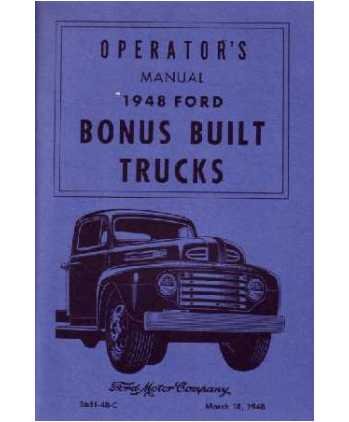ford f series 1948
Postal Code: 30901
Search locally
-
$20.78
For 1948-1955 Ford F Series Generator Drive End Bearing 49511VN 1949 1950 1951Norcross,GA,USA- 135mi -
$19.04
For 1948-1955 Ford F Series Wheel Cylinder Front Left Centric 76535WC 1949 1950Atlanta,GA,USA- 140mi -
$60.00
Brake Master Cylinder For 1948-1952 Ford F Series 1951 1949 1950 Q827CWAtlanta,GA,USA- 140mi -
$223.99
56MM Aluminum Radiator fit FORD F-SERIES TRUCK/PICKUP FLATHEAD V8 A/T 1948-1952Flat Rock,NC,USA- 130mi -
$37.67
Shock Absorber D911WM for F Series F100 Econoline Deluxe Super F250 1948 1951Atlanta,GA,USA- 140mi -
$44.99
1951 FORD F100 TRUCK STEERING COLUMN shift Linkage parts LOTStatham,GA,USA- 100mi -
$198.55
56MM ALUMINUM RADIATOR FIT FORD F-SERIES TRUCK/PICKUP FLATHEAD V8 A/T 1948-1952Flat Rock,NC,USA- 130mi -
$40.69
For 1948-1952, 1955 Ford F Series Shock Absorber Gabriel 47922PG 1949 1950 1951Atlanta,GA,USA- 140mi
-
$10.95
1948 1949 1950 1951 1952 FORD F SERIES TRUCKS PICKUP 10 Color Article F-1Greenville,SC,USA- 105mi -
$14.95
1948 FORD TRUCK SALES BROCHURE-LIGHT DUTY TRUCK-F-1 F-2 F-3 F-4 SERIES - GOODSalem,SC,USA- 115mi -
$14.95
1948 FORD TRUCK SALES BROCHURE-LIGHT DUTY TRUCK-F-1 F-2 F-3 F-4 SERIES - GOODSalem,SC,USA- 115mi -
$10.95
1948 1949 1950 1951 1952 FORD F SERIES TRUCKS PICKUP 10 Color Article F-1Greenville,SC,USA- 105mi -
$10.95
1948 1949 1950 1951 1952 FORD F SERIES TRUCKS PICKUP 10 Color Article F-1Greenville,SC,USA- 105mi -
$10.95
1948 1949 1950 1951 1952 FORD F SERIES TRUCKS PICKUP 10 Color Article F-1Greenville,SC,USA- 105mi
Learn more about ford f series 1948.
1948 FORD F-2 TRUCK - THE LONGER BED VERSION
The first-generation Ford F-Series is a series of pickup trucks and commercial vehicles produced by Ford Motor Company. Introduced in 1948, the F-Series was ...
-

317 Ford F-Series Pick-Up (1950)
Ford F-series Pick-Up (1948-52) Engine 3900cc (239 Cid) Flathead V8 FORD USA SET www.flickr.com/photos/45676495@N05/sets/72157623789312836... The First generation of the long lived series of Ford F-series pick-up...
Photo by robertknight16 on Flickr
-
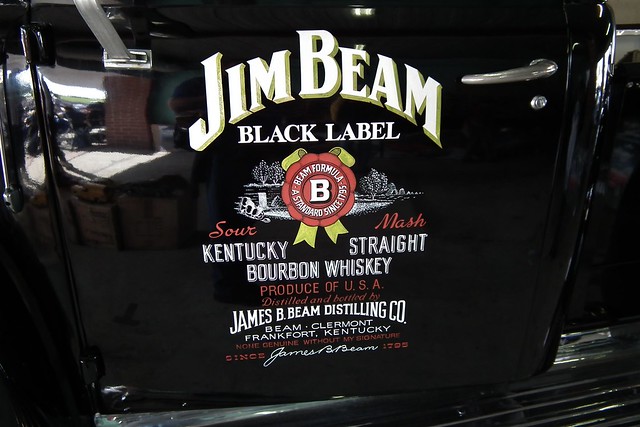
1948 Ford F Series pick up - Jim Beam
1948 Ford F Series pick up signwriting. The local distributors of Jim Beam Bourbon restored several late 40's and early 50's Ford pick ups in the late 1990's. They gave them away to liquor stores who achieved the...
Photo by sv1ambo on Flickr
-
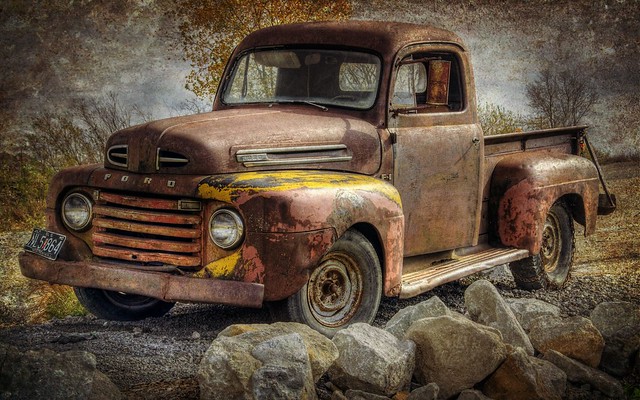
Henry F-1
It is not blue and it is not a Chevy. :) It is a 1950 Ford F-1. The F Series started in 1948 and continues today. Some textures done in Ipiccy and some were mine.
Photo by TicKavich on Flickr
-
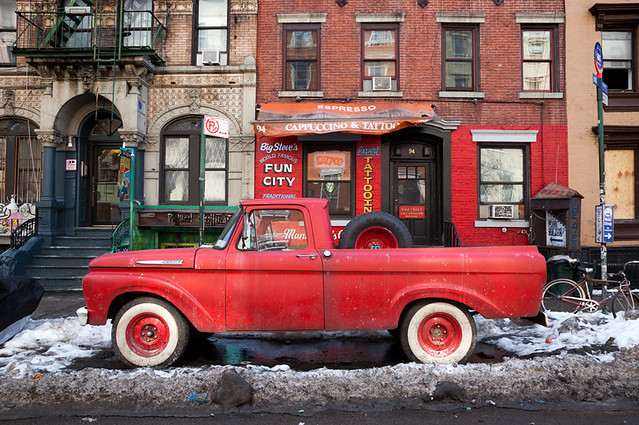
1961 Ford F100, East Village, NYC.
The Ford F-Series made its introduction on January 16th of 1948, beginning the legacy of F-Series trucks. Since that time, over 32 million trucks have been given the F-Series badge. These trucks have been the...
Photo by James and Karla Murray Photography on Flickr
-
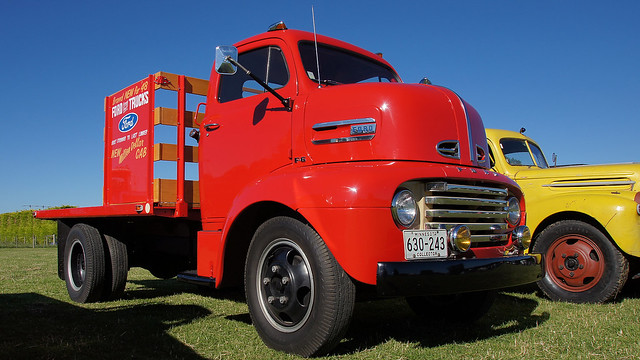
1948 Ford F-6 Truck.
The Ford Motor Company made a huge investment in its new line of trucks: $1 million to redesign the cab. The resulting “Million Dollar Cab,” as it was called, was used on all eight trucks in the series and brought a...
Photo by Hugh McCall on Flickr
-
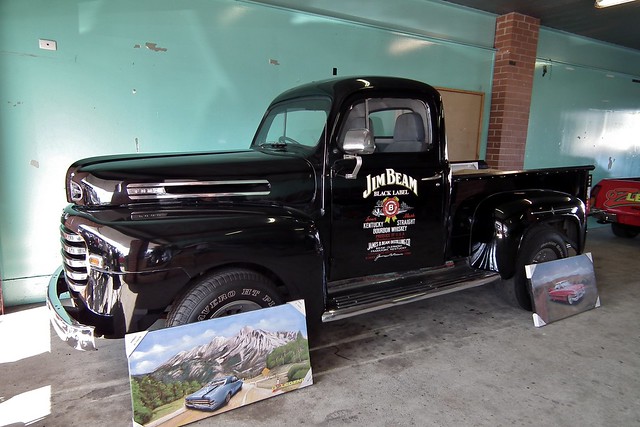
1948 Ford F Series pick up - Jim Beam
1948 Ford F Series pick up. The local distributors of Jim Beam Bourbon restored several late 40's and early 50's Ford pick ups in the late 1990's. They gave them away to liquor stores who achieved the biggest sales...
Photo by sv1ambo on Flickr
-
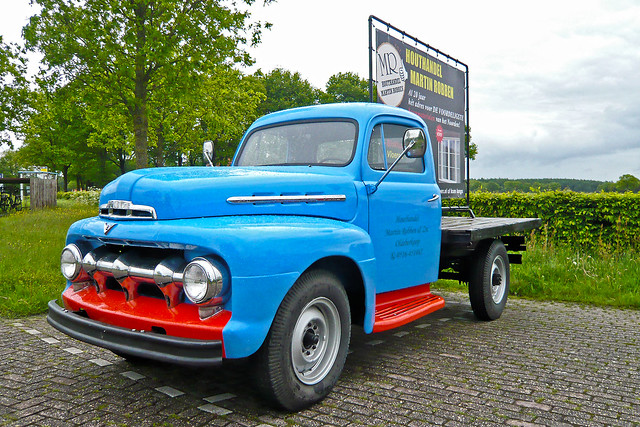
Ford F-3 V-8 (1170317)
- The F Series were the first post-war trucks from Ford (1948-1952). - They are also known as the Ford Bonus-Built. - The F-3 was a heavy duty 3/4 ton truck. Just photographed today on (working) road trip ?!
Photo by Le Photiste on Flickr
-
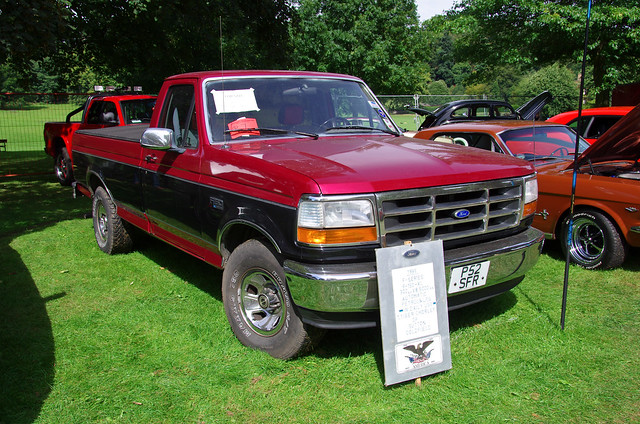
1996 Ford F-Series F150XL (5.0 litre V8 auto)
The F150 Ford was America's best selling pickup for over 30 years. Produced from 1948 in twelve models (or generations), between 1997 and 2012 alone over 11.9 million were sold - an average of almost 745,000 every...
Photo by Graham Woodward on Flickr
-

KAT Ford F-7
Shot around 1951, this KAT Ford is loaded with Jeeps. From a series of KAT photos I just bought. Note driver "Smitty" and tractor 3114. Trailer 6037 is an MHS with "porch" added making it a 5-car...
Photo by PAcarhauler on Flickr
-
Driving: 2015 Ford F-150
08/18/15, via Vancouver Courier
If you travel down South to Tacoma and walk through the doors of the LeMay automotive museum, you'll currently find a display dedicated to the history of the Ford F-series pickup truck. They've got workin' rigs stretching right back until 1948
-
The Only Kind of Washington Lawyer That's Gone Extinct
08/18/15, via Washingtonian.com (blog)
The options included Charles E. Ford, dubbed the Fifth Street Cicero, a flamboyant 220-pound advocate who once dispatched a client's first-degree murder charge by dramatically accusing him of manslaughter. His partner, H. Clifford Allder, defended Mae
-
1955 Ford C750 Truck
08/16/15, via Lima Ohio
Like other manufacturers that built COE trucks before the 1960s, early Ford C-Series trucks were “helmet-shaped”, cab-forward trucks that shared components with pickup trucks (the F-Series, in this case). From 1948-52, they were simply COE versions of
-
Class vs. Culture: Reframing Political Struggle
08/21/15, via CounterPunch
The bloodiest battles broke out in November 1945 and involved autoworkers; more then 300,000 General Motors workers walked off the job, quickly followed by strikes at Ford and Chrysler. In 1947, Pres. In the wake of Robert F. Kennedy's
-
Palm Springs Eternal
08/17/15, via W Magazine
So what does DiCaprio, movie star embodiment of ferocious uncertainty, mystery child-man in T-shirt and baseball cap, have in common with shellacked, peppy Shore, singer of 1948's hit “Buttons and Bows,” TV star of the '50s, '60s, and '70s, and long
-
J. Wallace LaPrade, New York FBI Chief in '70s, Dies at 89
08/12/15, via New York Times
He accused the administrations of both Mr. Carter and his predecessor, President Gerald R. Ford, of “political attempts” to influence “who and how” the F.B.I. investigated. He said he had been dismissed because he refused to divulge foreign
-
Mystery Place: Since 1907, Lawton family has owned land in LaGrange
08/15/15, via Janesville Gazette
Owners listed include Fred Lawton, Wm. H. Lawton, F. & Wm. Lawton and L.H. Phelps. In 1930 the Prairie Farmer's Reliable Directory of Farmers and Breeders of Walworth County, Wisconsin says Fred Lawton came to the area in 1880, married Ellie Brooks
-
 2013 NAIAS: Historic First-Gereration Ford F-Series - Live PhotosImage by www.autoevolution.com
2013 NAIAS: Historic First-Gereration Ford F-Series - Live PhotosImage by www.autoevolution.com -
 1948 Ford F Series Front Three QuartersImage by www.motortrend.com
1948 Ford F Series Front Three QuartersImage by www.motortrend.com -
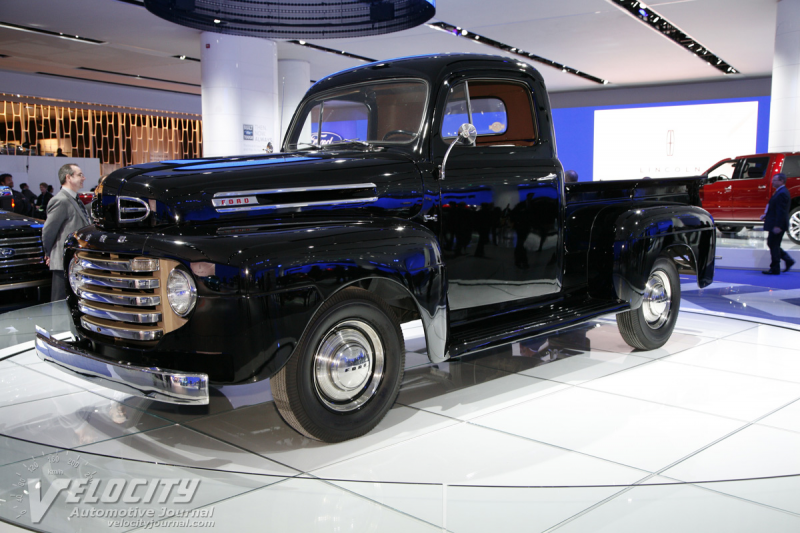 ... series pickups has Ford sold since the F series was launched in 1948Image by pickupnearyou.com
... series pickups has Ford sold since the F series was launched in 1948Image by pickupnearyou.com -
 Car Ford F-Series 1948–present WallpaperImage by desktopas.com
Car Ford F-Series 1948–present WallpaperImage by desktopas.com -
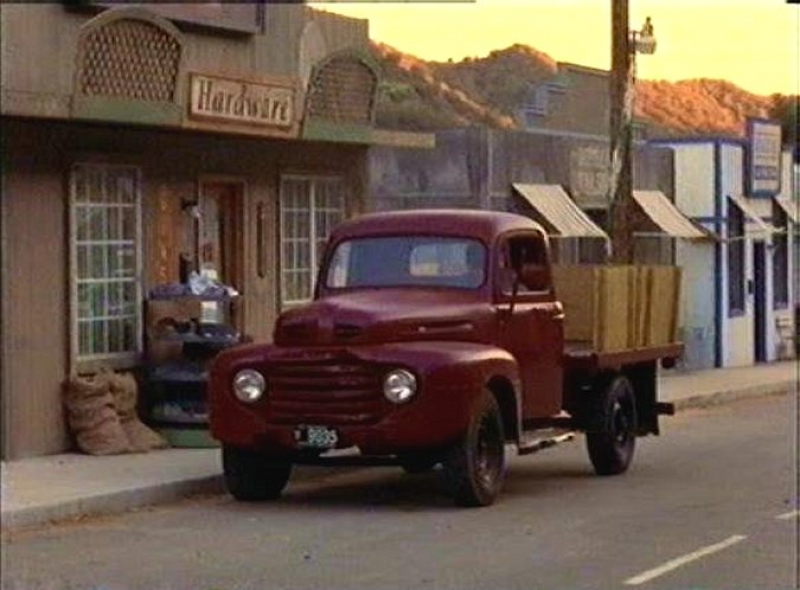 Vehicle used by a character or in a car chaseImage by www.imcdb.org
Vehicle used by a character or in a car chaseImage by www.imcdb.org -
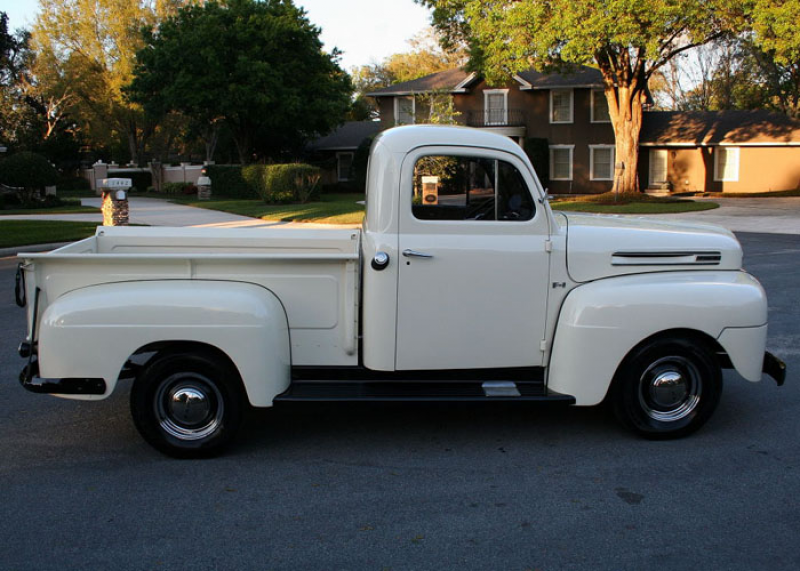 1948 Ford F Series photo galleryImage by background-pictures.picphotos.net
1948 Ford F Series photo galleryImage by background-pictures.picphotos.net -
 1948 ford f series pick up jim beam 1948 ford f series pick up the ...Image by www.flickriver.com
1948 ford f series pick up jim beam 1948 ford f series pick up the ...Image by www.flickriver.com -
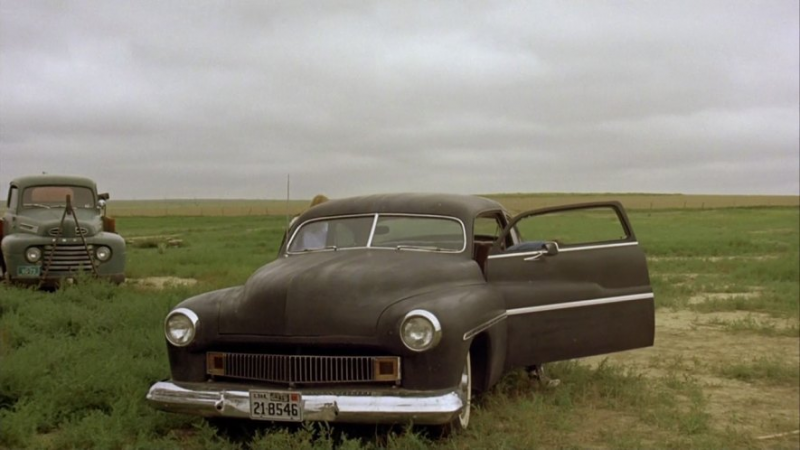 1948 Ford F-SeriesImage by www.imcdb.org
1948 Ford F-SeriesImage by www.imcdb.org
The Only Kind of Washington Lawyer That's Gone Extinct - Washingtonian.com (blog)
At one end of Washington’s legal food chain is K Street, home to swells known as lawyer-lobbyists. At the other is a breed known, when we refer to them at all, as Fifth Streeters: the last-ditch criminal-defense attorneys lurking around Moultrie Courthouse at Fifth and C streets, Northwest, waiting to get picked for your trial. Urban Dictionary defines Fifth Street lawyers as “the bottom-feeders in an industry already consisting of scum-suckers. Fifth Street used to be home to some of the best trial lawyers in DC’s history. That spot on the map had been the heart of the District’s legal world since the 19th century, and by the 1930s, “Go down to Fifth Street and get yourself a good lawyer” was a gentle way of saying, “You’ve got a problem. The options included Charles E. Ford, dubbed the Fifth Street Cicero, a flamboyant 220-pound advocate who once dispatched a client’s first-degree murder charge by dramatically accusing him of manslaughter. Stein, a partner at Stein Mitchell Muse Cipollone & Beato who represented Monica Lewinsky, rented his first office in 1948 for $35 a month at 635 F Street. Source: www.washingtonian.com
Class vs. Culture: Reframing Political Struggle - CounterPunch
On August 8, 2015, activists associated with the Black Lives Matter (BLM) movement disrupted a speech by Sen. Bernie Sanders (I-VT), the Democratic Party presidential candidate, at a public rally in Seattle, WA. Sanders was to speak on Social Security reform, but BLM activists demanded a 4-and-1/2 minute moment of silence to honor the 1-year anniversary... The Seattle showdown followed a similar disruption by BLM activists of a Sanders’ speech in July at the Netroots Nation conference in Phoenix, AZ. These incidents illuminate a fundamental split within the broadly conceived progressive movement, a... The site focuses on eight issues, five on bread-and-butter concerns (i. e. , wealth inequality, decent jobs, living wage, Wall Street reform and getting money out of politics) while three address values issues (i. e. , racial justice, family... Over the last half-century, the U. S. has been witness two distinct, if parallel, domains of political conflict, one involving economic opportunity (e. g. , jobs, wages, inequality), the other engaging social or cultural relations (e. g. , race,... Source: www.counterpunch.org
Palm Springs Eternal - W Magazine
This brings us to Palm Springs, playground of stars since Hollywood began, and, suddenly, once again, the capital of cool. Take this as a sign: Leonardo DiCaprio recently bought Dinah Shore’s Palm Springs house. So what does DiCaprio, movie star embodiment of ferocious uncertainty, mystery child-man in T-shirt and baseball cap, have in common with shellacked, peppy Shore, singer of 1948’s hit “Buttons and Bows,” TV star of the ’50s, ’60s, and ’70s, and... A midcentury house by the architect Donald Wexler with more than 7,000 square feet of right angles, spider-leg girders, and conversation pits, with a perfect view of the San Jacinto Mountains behind a cheerleader lineup of skinny palm trees. The architects Richard Neutra, John Lautner, Albert Frey, Hugh Kaptur, William Krisel, E. Stewart Williams, and Wexler imposed a stark geometry on the desert to create the Palm Springs style: flat-roof houses (which Norman Mailer described as... So much glass and so much outdoors say that the surroundings are safe, benign, and, even if the Palm Springs summer heat can fry the brain, there’s plenty of air-conditioning. Palm Springs is a playland where, from the Jazz Age onward, stars came to drink and carouse, have sex, and play tennis, golf, and polo. Source: www.wmagazine.com
-
1948 Ford F-Series
Buy 1948 ford F-Series at Amazon! Free Shipping on Qualified Orders.
-
Ford F-100 1948 on eBay
Big savings on Ford F-100 1948 on eBay Free Shipping available. Buy Now!
-
Ford F-Series - Wikipedia, the free encyclopedia
For the 1999–present F-250 and higher models, see Ford Super Duty. "F150" redirects here. For the 2011 Formula One race car previously named Ferrari F150, see Ferrari 150° Italia. "Ford F1" redirects here. For Ford factory Formula One racing efforts, see Stewart Grand Prix. Ford F-Series
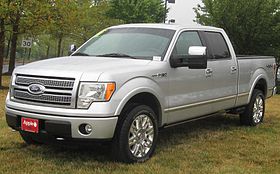
2010 Ford F-150 Platinum
Overview Manufacturer Ford Production 1948–present Body and chassis Class Full-size pickup truck Layout Front engine, rear-wheel drive / four-wheel drive Chronology Predecessor Model BB Successor Ford Super Duty (F-250, F-350, F-450, F-550, F-650, F-750)The Ford F-Series is a series of full-size pickup trucks from Ford which has been sold continuously since 1948. The most popular variant of the F-Series is the F-150. It has been the best-selling vehicle in the United States for the past 32 years,[1] and the best-selling pick-up for 43 years,[2] and the best selling vehicle in Canada,[3] In the tenth generation of the F-series, the F-250 and F-350 changed body style in 1998 and joined the Super Duty series.
During the post-World War II era, smaller Canadian villages had access to either a Ford dealer or a Lincoln-Mercury-Meteor dealer, but not both; a Mercury-badged version was sold at Lincoln-Mercury-Meteor dealers there from 1946–68. Other than the grilles, trim, and badging, these pick-ups were identical to their Ford counterparts.
As of 2015, the Ford F-150 is sold in the United States, Canada, Mexico, most Caribbean countries (except Trinidad and Tobago, Saint Kitts and Nevis and Cuba), Suriname, Ecuador, Peru, Chile, the Middle East, Iceland, Nigeria, the Dutch territories of Aruba, Curaçao, Sint Maarten and the British overseas territory of the Cayman Islands whilst the SVT Raptor is sold in the United States, Canada, Mexico, the Middle East, Ecuador, Chile and Peru. Both are available in LHD only. In Mexico, the Extended cab versions of the F-150 is called the Ford Lobo, while the Ford F-150 SVT Raptor is called the Ford Lobo Raptor.
Contents
1 First generation (1948–52) 2 Second generation (1953–56) 3 Third generation (1957–60) 4 Fourth generation (1961–66) 5 Fifth generation (1967–72) 6 Sixth generation (1973–79) 7 Seventh generation (1980–86) 8 Eighth generation (1987–91) 9 Ninth generation (1992–96) 9.1 E4OD transmission changes 9.2 Powerstroke diesel 9.3 SVT Lightning 10 Tenth generation (1997–2003) 11 Eleventh generation (2004–08) 12 Twelfth generation (2009–14) 13 Thirteenth generation (2015–present) 14 Special models 14.1 Camper Special 14.2 Eddie Bauer 14.3 F-150 Nite 14.4 SVT Lightning 14.5 Harley Davidson Edition 14.6 SVT Raptor 14.7 F-150 Platinum 14.8 F-150 Tremor 15 Motorsports 16 Awards and recognition 17 Sales 18 Other notes 19 Special use F-Series vehicles 20 See also 21 References 22 External links First generation (1948–52)[edit]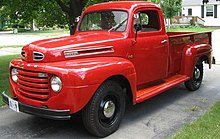
The first-generation F-Series pick-up (known as the Ford Bonus-Built) was introduced in 1948 as a replacement for the previous car-based pick-up line introduced in 1942. The F-Series was sold in eight different weight ratings, with pick-up, panel truck, cab-over engine (COE), conventional truck, and school bus chassis body styles.
Second generation (1953–56)[edit]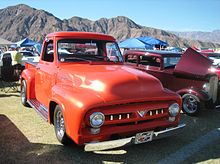
For the 1953 model year, an all-new version of the F-Series made its debut. Increased dimensions, improved engines, and an updated chassis were features of the second generation.
Additionally, a change to the F-Series naming scheme would remain in place to the present day. The half-ton F-1 became the F-100 (partially influenced by the North American F-100 Super Sabre); the F-2 and F-3 were combined into the F-250 while the F-4 became the F-350. Conventional F-Series trucks were F-500 to F-900; COE chassis were C-Series trucks.
Third generation (1957–60)[edit]
Introduced in 1957, the third-generation F-series was a significant modernisation and re-design. Front wings became integrated into the body, and the StyleSide bed continued the smooth lines to the rear of the pick-up.
The cab-over F-Series was discontinued, having been replaced by the tilt-cab C-Series.
In 1959, Ford began in-house production of four-wheel drive pick-ups.
Fourth generation (1961–66)[edit]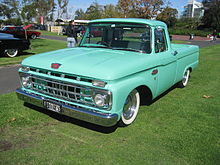
Ford introduced a dramatically new style of pick-up in 1961 with the fourth-generation F-series. Longer and lower than the previous pick-ups, these trucks had increased dimensions and new engine and gearbox choices. Additionally the 1961-1963 models were constructed as a uni-body design with the cab and bed integrated. This proved unpopular and the F-series reverted to a traditional separate cab/bed design in 1964.
In 1965 the F-series was given a significant mid-cycle redesign. A completely new platform, including the Twin-I-Beam front suspension, was introduced that would be used until 1996 on the F150 and till this day on the F250/F350 4x2. Additionally that year, the Ranger name made its first appearance on a Ford pick-up; previously a base model of the Edsel, it was now used to denote a high-level styling package for F-Series pick-ups.
Fifth generation (1967–72)[edit] 1972 F-250 Camper Special
1972 F-250 Camper Special
Introduced in 1967, the fifth-generation F-series pick-up was built on the same platform as the 1965 revision of the fourth-generation. Dimensions, and greenhouse glass were increased, engine options expanded, and plusher trim levels became available during the fifth-generation pick-ups production run.
Suspension components from all 1969 F-Series models are completely inter-changeable.
A variant of the fifth-generation F-series was produced until 1992 in Brazil for the South American market.
Sixth generation (1973–79)[edit]
The sixth-generation F-series was introduced in 1973. This version of the F-series continued to be built on the 1965 fourth-generation's revised platform, but with significant modernizations and refinements. Front disc brakes, increased cabin dimensions, gas tank relocated outside the cab and under the bed, significantly improved heating and air conditioning, full double wall bed construction, increased use of galvanized steel, SuperCab was introduced in the sixth-generation pick-up.
The FE engine series was discontinued in 1976 after a nearly 20-year run, replaced by the more modern 335 series (Modified) and 385 series engines.
In 1975, the F-150 was introduced in between the F-100 and the F-250 in order to avoid certain emission control restrictions. For 1978, square headlights replaced the previous models' round ones on higher trim package models, such as Lariat and Ranger, and in 1979 became standard equipment. Also for 1978, the Ford Bronco was redesigned into a variant of the F-series pick-up. 1979 was the last year that the 460 large block engine was available in a half ton truck.
Seventh generation (1980–86)[edit]
The 1980 F-Series was redesigned with an all-new chassis and larger body; this was the first ground-up redesign since 1965. The exterior styling of the truck was redone to improve aerodynamics and fuel economy. Medium-duty F-Series (F600-F900) were also redesigned; although they shared the cabin of the smaller pickup trucks, the largest version of F-Series now wore a bonnet with separate front wings (like the L-Series). Medium duty Ford F-Series would carry the 1980-86 interior design until 2000 (though pickups were restyled again in 1987 and 1992), with very subtle changes such as window glass and electronics.
In a move towards fuel efficiency, Ford dropped the M-Series engines (5.8L, 351M and 6.6L, 400 C.I. V8's) in 1981 and added the 4.2L, 255 C.I. and 5.8L, 351 C.I. Windsor V8 engines from the Panther platform. The 255 V8 was simply a 5.0L, 302 V8 with a smaller bore, built specifically for better fuel economy, but was dropped for the 1982 model year due to being underpowered and having limited demand. For 1982 and 1983, the 3.8L, 232 C.I. Essex V6 was the base engine but was quickly dropped for the 1984 model year. In 1983, Ford added diesel power to the F-Series through a partnership with International Harvester (later Navistar). The 6.9L, 420 C.I. IDI V8 produced similar power output as the gasoline 351 Windsor V8, with the fuel economy of the 4.9L, 300 I6. 1985 was the first year of electronic fuel injection on the 5.0L V8, all other engines following suit in 1988. There was a new "high output" version of the 5.8L Windsor beginning in 1984.
A noticeable change was made to the F-Series in 1982 as the Ford "Blue Oval" was added to the center of the grill, also the Ranger and Custom trims were no longer available. The Ranger name had been shifted onto the all-new compact pickup developed as a replacement for the Courier. The new trim levels were a no-badge base model (essentially the new Custom), XL, a very rare XLS, and XLT Lariat.
1983 marked the final year of the F100, making the F150 the lightest pickup available on the market. F100's and F150's were virtually identical with the exception of smaller brakes and a 5x4.5 bolt pattern on the F100 axles, as opposed to 5x5.5 on the F150. F100's over a certain GVWR and/or without power brakes did use the F150 axles. Also, the 1980-83 F100 was never offered with four wheel drive.
1986 marked the final year that the F150 was available with a 3-speed manual gearbox that shifted via a steering column lever (3-on-the-tree). Incidentally, this was the second-last vehicle in the United States that offered this set up. 1986 was also the last year the Explorer package was available.
This is the first generation of trucks to incorporate amenities such as power mirrors, power windows, and power door locks.
Eighth generation (1987–91)[edit]Ford F-350 U-Haul truck in Hampton, VA (Heavy-Duty type)
.
 Ford F-150 (light-duty type)
Ford F-150 (light-duty type)
Ford's 1987 F-Series carried over the same body style from the 7th generation, yet sported a new rounded front clip that improved aerodynamics, as well as the softening of body lines around the rear of the bed and fender arches around the wheel wells. The interior was also completely redesigned in 1987. The Custom trim made a comeback for the 8th generation. In 1988, the 4.9L I6, 5.8L V8 and 7.5L, 460 C.I. V8 gained electronic fuel injection. International Navistar also increased the displacement of their 6.9L V8 this year, resulting in the new 7.3L, 444 C.I. IDI V8. This was also the first year of a 5-speed manual overdrive transmission, which included the Mazda M5OD in the F150's and the heavy-duty ZF5 in the F250's and F350's, 4-speed manuals were dropped as standard equipment after 1987, but were available as a customer-ordered option until 1989. In 1989, the C6 3-speed automatic was replaced as the base automatic transmission with the E4OD, a 4-speed electronically controlled automatic overdrive unit, though the C6 was still available as an option, mostly in F250's and F350's, until 1997. Heavy-Duty models included F-250s and F-350s (along with F-Super Dutys) that were classified as incomplete vehicles that were produced with no bed, but appeared as Tow Trucks, Box Trucks (notably U-Haul), Flatbed Trucks, Dump Trucks and other models that are known to be incomplete vehicles. These models appear from 1987 to 1997.
Ninth generation (1992–96)[edit] Ford F-350 U-haul truck being refueled
Ford F-350 U-haul truck being refueled
The F-Series underwent another minor cosmetic update for the 1992 model year with an updated front clip focused on increasing its aerodynamics. The update also brought the F-Series in line with the Ranger and Explorer stylistically. The interior was also redesigned at this time. One major interior update included the addition of rear speakers. The XLT Lariat name was shortened to simply XLT in 1992, and Ford's base Custom truck trim became the XL.
SuperCab models of this generation are distinguished by single (instead of twin) side windows for the rear seat. Dormant since 1987, the FlareSide bed also returned for 1992. Instead of the traditional pickup bed seen before, the new FlareSide borrowed much of its rear bodywork from the dual rear-wheel F-350.
Ford offered a 75th anniversary package on its 1992 F-series, consisting of a stripe package, an argent colored step bumper, and special 75th anniversary logos.
In 1995, the medium-duty trucks received their first exterior update since 1980 that integrated the indicators and grille. Also, Ford upgraded the F-Series top trim level with the plusher Eddie Bauer Edition, previously only available on Broncos since 1985. SuperCab models offered new 40/20/40 split bench/bucket seat to replace the previously 50/50 split jump seats.
All 1996 F150s received mass air flow sensors, replacing the older speed/density set up. 1996 and some late 1995 F-150s also have OBD2, replacing the old OBD1 system. The F250HD and F350, however, would remain unchanged through the 1996 model year.
E4OD transmission changes[edit]The E4OD electronically-controlled transmission with overdrive also underwent several updates during the 1992–1997 model years. For the 1992 year model, the E4OD received four-pinion planet carriers, an updated sun gear, rear case bushings, and a stronger overdrive clutch cylinder snap ring. For the 1994 model year, the transmission received updates to the center support, replacing bushings with ball bearings. A new, stronger four-pinion planet overdrive carrier replaces older three- and four-pinion designs. A revised converter clutch piston was also added in with the 1994 update. 1995 E4OD transmissions received a higher displacement front pump, which helps engage reverse quicker. 1996 was updated to be compatible with OBD2 systems.
Powerstroke diesel[edit]Starting in 1994.5, Ford offered the F-250 and F-350 models not only with gasoline engines, but with new redesigned direct injection turbodiesel engines. The 7.3 liter diesel was manufactured by the International company, also known as Navistar. International upgraded the 7.3 diesel previously used in Ford heavy duty trucks and added a direct-injection fuel system, larger single shot injectors, a turbocharger, and newly designed pushrods. Ford named the new diesel engine the Powerstroke. The Powerstroke brought better performance, power, and towing capacity in Ford trucks. The 7.3 Powerstroke diesel lasted until 2003.5, when it was replaced by the 6.0 Powerstroke. In 1999 an intercooler and new piston rods were included in all Powerstroke diesel engines.
SVT Lightning[edit]The first SVT Lightning truck entered the scene in 1993. It featured a 5.8 L engine with performance GT40 cylinder heads shared with 5.0 Mustang Cobra, cam, pistons, intake shared with the 5.0 H.O. Mustang, headers, dual exhaust, oil cooler and modified engine computer programming. The truck was available with a reprogrammed E4OD automatic transmission with an auxiliary cooler. The rear axle was a limited slip unit with 4.10:1 gearing. Ford added a high-mount third brake light to the rear of 1994 truck cab roofs. More safety-related moves this year included a security package with remote keyless entry and intrusion alarm; also driver airbag was standard on the F150 for the first time.
Tenth generation (1997–2003)[edit]Introduced in late of 1996, the 1997 F-150 was redesigned from the ground up for the first time since 1980. Rounded styling allowed for improved aerodynamics, a larger interior, and improved fuel economy. Sharing a similar V6 engine with the Taurus/Windstar and a V8 engine with the Crown Victoria and Mustang, late 1997 F-150 received an all-new 5.4L engine. To improve rear-seat access, a third door was added to SuperCab models; in 1998, SuperCabs became four doors. For 2001, the SuperCrew crew cab was added; it combined the larger seat of a crew cab with a slightly shortened rear cargo bed.The "Tenth Generation" of the Ford F-Series had the following trims: XLT, Lariat and King Ranch and the odd Harley Davidson edition.
This generation of the F-Series marked the split of the F-150 from heavier-duty pick-ups. For 1997, all F-150s and lighter-payload F-250s used the new chassis, while heavy-payload F-250s and larger trucks remained on the existing platform. For 1998, only the F-150 and F-250LD were produced. In 1999, the F-250LD was rebadged the F-150 7700, and a new line was introduced, the Ford Super Duty. Super Duty models ranged from the F-250 through the F-750; the F-250 through F-550 (the latter being a chassis-cab model) were Ford manufactured and intended to replace the F-250 through F-Super Duty, while the F-650/F-750 was a joint venture with International, a replacement for the previous medium-duty trucks. In 1999, Ford developed and released the 20 valve Triton V10, 6.8L (415 CID) good for 305 Horsepower and 425 Lb-Ft of torque.
For 2002, this version of the F-150 was sold by Lincoln-Mercury dealers as the Lincoln Blackwood. The first Lincoln pickup, the Blackwood was an F-150 SuperCrew with Lincoln Navigator front bodywork and interior. Unlike most pickup trucks, the pickup bed was redesigned into a trunk with a powered tonneau (decklid) and a fully lined and finished bed.
In 2001, Ford introduced the King Ranch Edition for the super crew (and very limited special order super cab). This gives the truck a 2 tone paint scheme with black, white, brown, blue, or green primary color with a beige lower paint. The King Ranch trim has real cowhide saddle leather seats and console lid made by The King Ranch, with bucket seats and console in the back as an option.
The SVT Lightning was produced from 1999-2004 (Heritage) and was available only as a single cab step side bed. It was powered by a Supercharged 5.4L 2v and had the heavy duty 4R100 transmission.
In 2000, Ford introduced the Harley Davidson Edition.
Eleventh generation (2004–08)[edit]
For the 2004 model year, the F-150 was redesigned on an all-new platform. Externally similar to its predecessor, the eleventh-generation wore sharper-edged styling; a major change was the adoption of the stepped driver's window from the Super Duty trucks. Regardless of cabin type, all F-150s were given four doors. Ford also introduced the Triton engines in the 5.4L variants of the F-150.
In late 2006, the Super Duty trucks were also given an all-new platform. While using the same bed and cabin as before, these are distinguished from their predecessors by an all-new interior and a much larger grille and head lamps. Previously available only as a chassis-cab model, the F-450 now was available as a pick-up directly from Ford.[4]
From 2005 to 2008, Lincoln-Mercury dealers sold this version of the F-150 as the Lincoln Mark LT. Replacing the Blackwood, the Mark LT had a useful bed in place of its predecessor's trunk, but it was not a success in the United States. This model was discontinued in 2008.
Twelfth generation (2009–14)[edit]
The twelfth generation F-150 was introduced for the 2009 model year as an update of the Ford full-size truck platform. Similar to its predecessor, These trucks are distinguished by their Super Duty-style grilles and head lamps; standard cab models again have two-doors instead of four. The FlareSide bed was continued until 2010, dropped along with the manual gearbox; outside of Mexico, the Lincoln Mark LT was replaced by the F-150 Platinum. A new model for 2010 included the SVT Raptor, a dedicated off-road pick-up.
As part of a major focus on fuel economy, the entire engine lineup for the F-150 (excluding the SVT Raptor) was updated for the 2011 model year. Along with two new V8 engines, the F-150 gained a new 3.7-Litre base V6 engine, and a powerful twin-turbocharged 3.5-Litre V6, dubbed EcoBoost by Ford. The automatic gearbox is the only option. Other modifications include the addition of a Nexteer Automotive Electric Power Steering (EPS) system on most models.
A recent study[5] conducted by iSeeCars.com and published on Ford website listed Ford F-250 Super Duty as the top longest lasting car and Expedition, Explorer and F-150 in the top 20 longest lasting cars.
Engine options (North America - as of 10/20/2013) [1]:
Cylinders Size Horsepower Torque VIN code (8th digit) V6 EcoBoost 3.5 L 365 420 lb-ft @ 2500 rpm 8 V6 3.7 L 302 278 lb-ft @ 4000 rpm 8 V8 5.0 L 360 380 lb-ft @ 4250 rpm 8 V8 6.2 L 411 434 lb-ft @ 4500 rpm 8 Thirteenth generation (2015–present)[edit] The thirteenth generation F-150 at the 2014 North American International Auto Show
The thirteenth generation F-150 at the 2014 North American International Auto Show
Unveiled at the 2014 North American International Auto Show on January 13, 2014, the all-new F-150 derives much of its exterior styling from the 2013 Ford Atlas concept vehicle.
In an effort to increase fuel economy, the 2015 model reduces its curb weight by up to 700 pounds through the extensive use of aluminum in the body structure and high strength steel in the frame.[6] The only major component of sheet metal not made from aluminum is the Quiet Steel sound-absorbing firewall.[7][8]
Retaining the use of body-on-frame construction, the frame is constructed with 77% high-strength steel (up from 23%).[7] The frame is manufactured in Elizabethtown, Kentucky by Metalsa which purchased Dana's structural products business.[9][10]
To showcase the durability of the aluminum-intensive design, Ford entered disguised prototypes of the model in the Baja 1000, which it completed.
The 2015 F150 is the first pickup truck with Adaptive Cruise Control, which uses radar sensors on the front of the vehicle to maintain a set following distance between it and the vehicle ahead of it, decreasing speed if necessary.
Two engines are carried over from the 2014 F150, including the 3.5L V6 Ecoboost and 5.0L V8. New for 2015 is a 2.7L V6 Ecoboost, and a 3.5L V6 replaces the 2014 3.7L V6 as the base engine. The 3.5L V6 and 5.0L V8 are naturally aspirated and feature Twin Independent Variable Camshaft Timing (Ti-VCT), both have aluminum blocks and heads.
The 2.7L and 3.5L Ecoboost engines both feature twin turbos and direct fuel injection.
Engine options (North America - as of March 2015) [2]:
Feature Cylinders Displacement Horsepower Torque (lb-ft) Ti-VCT V6 3.5 L 282 @ 6250 rpm 253 @ 4250 rpm Ti-VCT V8 5.0 L 385 @ 5750 rpm 387 @ 3850 rpm Ecoboost V6 2.7 L 325 @ 5750 rpm 375 @ 3000 rpm Ecoboost V6 3.5 L 365 @ 5000 rpm 420 @ 2500 rpmThe vehicle was recently awarded a 5 star crash rating by the National Highway Traffic Safety Administration.[11]
Special models[edit] Camper Special[edit]Available in various forms on the fourth, fifth, and sixth generation F-Series (1961-1979), the Camper Special was an option package on non-F100 pickups for owners of truck campers. Features included heavier-duty suspension and alternators, increased engine cooling, and pre-wiring for the truck camper.
Eddie Bauer[edit]For 1995, Ford introduced the Eddie Bauer trim level for the F-150. In a fashion similar to the same trim packages on the Aerostar, Bronco, and Explorer/Bronco II, it consisted of outdoors-themed interior trim with two-tone exterior paint.
F-150 Nite[edit]The "Nite" package was a special edition package that was available in 1991 and 1992. The package was for the most part an appearance package, with the most noticeable features being the black paint & trim, and special multicolor stripe. The Nite package (available on the XLT Lariat truck) also included 235/75/15 white-letter tires, alloy wheels, and sport suspension. In 1991, you could only get a "Nite" truck in a regular cab F150. In 1992, you could get it in any style F150 (styleside, supercab, etc.) in addition to the Bronco. These trucks came with either a 302 (5.0L) or 351 (5.8L) V8, and in either 2 wheel drive or 4 wheel drive.
SVT Lightning[edit]
 Second-generation Ford SVT Lightning
Second-generation Ford SVT Lightning
The SVT Lightning is a sports/performance version of the F-150, released by Ford's Special Vehicle Team (SVT) division. Introduced for the 1993 model year, the SVT Lightning competed against the Chevrolet 454SS, primarily as an effort to enhance the sporty, personal-use image of the Ford F-Series pick-up. Powered by a 240 hp 5.8-Litre V8, the Lightning shared its basic structure with the F-150, but many modifications were made to the suspension and the frame to improve the handling. Production was 11,563 SVT Lightnings between 1993 to 1995.
In 1999, after a three-year hiatus, Ford SVT unveiled a new version of the Lightning. Much like its predecessor, it was based on the F-150 with substantial suspension modifications. Although the Lightning shared its 5.4-Liter V8 with the standard F-150, it now used a supercharger, producing 360 hp (380 after 2001). To handle the extra power, the 4-speed automatic gearbox was borrowed from Ford's V10/diesel Super Duty pick-ups. 28,124 SVT Lightnings were produced from 1999 until the vehicle was discontinued in 2004.
Harley Davidson Edition[edit]In 2000, Ford released the first Harley Davidson Edition F-150; it was available in a SuperCab with a standard-length bed. For 2001, the Harley-Davidson Edition was moved to the Supercrew F-150. In 2002, Ford opted to further specialise the Harley Davidson Edition by adding the supercharged engine from the SVT Lightning, with a slightly larger upper pulley to reduce boost by 2 lbs. To coincide with Harley-Davidson's centenary, the 2003 edition added the requisite 100th Anniversary badging; these were available on Supercrew F-150s with the supercharged 5.4-Liter V-8.
For the 2004–09 F-150, the Harley-Davidson Edition became mainly an appearance package; its availability was expanded to the F-250 and F-350 Super Duty series.
On February 10, 2008 at the St. Louis Auto Show, the latest version of the Harley-Davidson F-150 was introduced. Adopting many luxury features of the Platinum Edition, this Harley went one step further by providing leather seating surfaces derived from authentic Harley biker-jacket materials, as well as the requisite exhaust tones and power to reach a top speed of 115 miles per hour (185 km/h).[12]
In 2012 Ford discontinued the Harley Davidson Edition and replaced it with the Limited edition.
SVT Raptor[edit]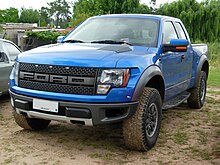
For the 2010 model year, Ford introduced the SVT Raptor model of the F-150. Intended for dedicated off-road use, the Raptor has a number of modifications to improve its off-road ability. It includes a full set of FOX shocks with 11.2" of front suspension travel and 12.1" of rear travel. It wears a wider body and wings than the standard F-Series truck. In a departure from the F-150, the Raptor wears no blue-oval Ford emblem on its grille (for the first time since 1981); instead, the grille has "FORD" spelled out in the center. In 2011, a full four-door SuperCrew lift kit model was added to the standard 4+4 door SuperCab model.
The Raptor is powered by a 411 hp 6.2-Liter V8 (shared with the Ford Super Duty; a 5.4 liter V8 was available for the 2010 model year); it is paired with a 6-speed automatic gearbox.
F-150 Platinum[edit]
Ford ceased sales of the Lincoln Mark LT in the United States and Canada after the 2008 model year.[13] In its place beginning in the 2010 model year, Ford created an upper-end trim of the 2009 F-150 called F-150 Platinum. Due to its continuing popularity there, the Platinum is rebadged as the Lincoln Mark LT in Mexico.
F-150 Tremor[edit]For the 2014 model year, Ford introduced the Tremor model of the F-150. The Tremor was released as high-performance sport truck for street truck enthusiasts. The Tremor is based on the style of the FX Appearance Package with the 3.5 liter EcoBoost engine and a 4.10 rear axle. The interior uses a floor mounted shifter, custom bucket seats and a flow-through center console not found in any other F-150. The Tremor is available in both 4x2 and 4x4. Both options feature an electronic locking rear differential and customized suspension. 2230 total Tremor's were built
Motorsports[edit]The truck won the San Felipe 250 eight times between 1999 and 2007.
Greg Biffle won the 2000 NASCAR Craftsman Truck Series.
Drivers such as Roger Norman and Larry Roeseler won the Primm 300 in 2003, 2007 and 2008.
In 2008, Ford announced its entrance into the Baja 1000 class-eight race for moderately modified, full-size pick-ups. The driver of record was Steve Oligos, supported by co-drivers Randy Merritt, Greg Foutz, and Bud Brutsman.[14] The vehicle was built with collaboration between the Ford Special Vehicle Team (SVT), Ford Racing, and Foutz Motorsports, Inc. The Ford F-150 SVT Raptor R completed the 2008 41st Tecate SCORE Baja 1000 race in 25.28:10,[15] and ranked third in its class.[16]Tavo Vildosola and Gus Vildosola won the event in 2010.
In the Best In The Desert race series, a F150 SVT Raptor R completed the "Terrible's 250" race, placing second overall in the Class 8000.[17]
In January 2010, a single Raptor SVT (#439), driven by Chilean driver Javier Campillay, competed in the Argentina-Chile Dakar Rally. However, the pick-up was unable to finish due to a catch-up crash with another car in the middle of the road during stage seven. In January 2011, two Raptors started in the Argentina-Chile Dakar Rally in Buenos Aires, with Campillay driving the more reliable Raptor (#375), and American female driver Sue Mead driving a T2 Raptor (#374). Mead crossed the finish line in Buenos Aires and won the "Super Production" class, the first North American class win in Dakar history. Campillay was unable to finish the 12th stage after losing time due to mechanical failure during the 11th stage, which led to his disqualification for failing to reach the race camp by the designated deadline.
Awards and recognition[edit]The Ford F-150 has won numerous awards; in 2009 alone, it received:[18]
Motor Trend 2009 Pick-Up of the Year Award 2009 Best Redesigned Vehicle from Kelley Blue Book's kbb.com Top honors as "Truck of Texas" as well as "Best Luxury Pickup" for the 2009 F-150 King Ranch from Texas Auto Writers Association "Best Overall Half-Ton Pick-up" from PickupTrucks.com "Automotive Excellence" award in the Workhorse Category from Popular Mechanics "Top Safety Pick" from the Insurance Institute for Highway Safety for its standard safety technology: Safety Canopy side curtain air bags and AdvanceTrac with Roll Stability Control "Residual Value" award from Automotive Leasing Guide (ALG) for retaining the highest percentage of its original price among 2009 full-size light-duty pickups at the end of a conventional three-year lease, based on ALG projections Motor Trend's Truck Trend Top 5 Pick-ups from Specialty Equipment Market Association (SEMA) for 2009 Ford F-150 Heavy Duty DeWalt Contractor Concept "Accessory-Friendly Pick-up" Design Award from SEMA Calendar Year United States Canada Norway World 1997 746,111[19] 1998 836,629 1999[20] 869,001 2000 876,716 2001[21] 911,597 2002[22] 813,701 2003 845,586 68,375 913,961 2004[23] 939,511 71,790 1,011,301 2005 901,463 69,549 971,012 2006[24] 796,039 72,128 868,167 2007 690,589 73,618 764,207 2008[25] 515,513 67,749 583,262 2009[26] 413,625 81,396 495,021 2010[27] 528,349 97,913 [28] 626,262 2011 584,917 96,325 681,242 2012 645,316 106,358 [29] 751,674 2013 763,402[30] 122,325 885,727 2014 753,851[31] 126,277[32] 880,128 Other notes[edit]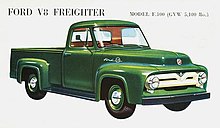 This 1955 Australian F-100 Freighter had special high side panels, perhaps unique to Australia; note the right-hand drive.
This 1955 Australian F-100 Freighter had special high side panels, perhaps unique to Australia; note the right-hand drive.
Ford also manufactures F-Series medium and heavy-duty pick-ups alongside the F-150, F-250, and F-350s (F-450, F-550, F-650, F-750 Super Duty trucks). Prior to 1998 in the United States, there were a number of variants sold alongside the F-Series.
B-Series (1948-1998) - school bus chassis based on medium-duty F-Series Econoline/E-Series (1975-2014) - mechanically related to F-Series P-Series - parcel delivery van chassis An F-8000 was also produced based on the Ford Cargo cab-over range, which was similar to the 2006 and newer Ford LCF ("Low Cab Forward").While previously a unique platform, after their 1975 redesign, the Econoline/E-Series vans have maintained strong similarity with the F-Series pickup trucks, although it is now only mechanically true, as the latter has now undergone a number of redesigns since the last update of the vans in 1992.
Medium-duty variants of the F-Series have their own chassis, sharing only the cab with lower-GVWR models. The current generation of F-650/F-750 Super Duty models combine the Ford Super Duty cab with a chassis shared with the International DuraStar line of trucks.
Right-hand drive versions of the F-Series (for the United Kingdom and Australia) are manufactured in Brazil.
In Argentina and Brazil, the petrol engines are often converted to also run with alternative fuels, E-96h (Brazilian-spec ethanol) and Compressed Natural Gas (CNG). Biodiesel also is used in diesel engines.
Special use F-Series vehicles[edit],_Beach_--_2012_--_3.jpg/120px-Pismo_Beach_(California,_USA),_Beach_--_2012_--_3.jpg)
Lifeguard in Pismo Beach, California

Firetruck in Curico, Chile


Repairing power lines in Caruthersville, Missouri

Bus for disabled in Toronto
.jpg/120px-Vehiculo_policial_de_la_U.C.M._-_Ford_Super_Duty_-_Polic%C3%ADa_Nacional_de_Panam%C3%A1_(2011).jpg)
Police crowd control in Panama
Catering truck at John F. Kennedy International Airport


Microwave broadcasting vehicle in Chengkungling, Taiwan

Ambulance in Loudoun County, Virginia

At car wash in Round Rock, Texas

Special forces vehicle for hijacked planes in Italy
.jpg/120px-Road-rail_vehicle_(13970120179).jpg)
Railroad maintenance in Tampa, Florida

Seafood delivery in Scranton, Pennsylvania
Taxi in Saint Thomas, U.S. Virgin Islands
.jpg/120px-Bush's_motorcade_in_Zagreb_(3).jpg)
Motorcade for U.S. President George W. Bush in Zagreb, Croatia
Camper at Core Banks, North Carolina

Tow truck in Horsens, Denmark

U.S. Border Patrol in Tucson
WikiLeaks Top Secret Information Collection Unit in New York City

Mosquito Control in New Orleans

Race car in Avondale, Arizona
See also[edit] Ford Super Duty Ford F-650 Sterling Trucks Bullet pickup References[edit] ^ -
Ford F-Series first generation - Wikipedia, the free ...
Main article: Ford F-Series
 This article relies largely or entirely upon a single source. Relevant discussion may be found on the talk page. Please help improve this article by introducing citations to additional sources. (March 2014)
This article relies largely or entirely upon a single source. Relevant discussion may be found on the talk page. Please help improve this article by introducing citations to additional sources. (March 2014)
 This article needs additional citations for verification. Please help improve this article by adding citations to reliable sources. Unsourced material may be challenged and removed. (March 2014)
First generation
This article needs additional citations for verification. Please help improve this article by adding citations to reliable sources. Unsourced material may be challenged and removed. (March 2014)
First generation

1950 Ford F-3
Overview Manufacturer Ford Also called Ford Bonus-Built Production 1948–1952 Model years 1948–1952 Assembly Chester, Pennsylvania, USADearborn, Michigan, USAEdison, New Jersey, USALong Beach, California, USANorfolk , VirginiaSt. Paul, MinnesotaSt. Louis, Missouri, USAHapeville, Georgia, USAHighland Park, Michigan, USA Body and chassis Class Full-size pickup truck Body style 2-door pickup4-door panel truck Layout Front engine, rear-wheel drive / four-wheel drive Powertrain Engine 226 cu in (3.7 L) I6239 cu in (3.9 L) Flathead V8254 cu in (4.2 L) I6337 cu in (5.5 L) Flathead V8215 cu in (3.5 L) I6279 cu in (4.6 L) Y-block V8317 cu in (5.2 L) Y-block V8 Transmission 3-speed manual4-speed manual5-speed manual Chronology Predecessor 1941-1947 Ford pickup Successor Ford F-Series second generation (1953–1956) 1950 F-6 with a 254-CID straight-six
1950 F-6 with a 254-CID straight-six
The first-generation Ford F-Series is a series of pickup trucks and commercial vehicles produced by Ford. Introduced in 1948, the F-Series was the first post-war truck design from Ford. In a break from previous Ford trucks, the F-Series was no longer based upon its car chassis, but on a dedicated truck platform. This generation of the F-Series would remain in production until 1952. F-Series trucks were assembled at sixteen different Ford factories. Serial numbers indicate the truck model, engine, year, assembly plant, and unit number. The most common model was the F-1 with a 6?½-foot bed followed by the F-2 and F-3 Express models with an 8-foot (2.4 m) bed.
Contents
1 Design 2 Models 3 Powertrain 3.1 Engines 3.2 Transmissions 4 ReferencesThe first F-Series truck (known as the Ford Bonus-Built) was introduced in 1948 as a replacement for the previous car-based pickup line introduced in 1941. It had a flat, one-piece windshield and integrated headlamps.[1] It had a wider cab.[1] Options included the "See-Clear" windshield washer (operated by foot plunger), passenger-side windshield wiper & sun visor, and passenger-side taillight. The F-1 truck was also available with additional chrome trim and two horns as an option. All F-series were available with optional "Marmon-Herrington All Wheel Drive" until 1959.
Design of the F-Series truck changed tremendously from 1950 to 1954. From 1948 to 1950, the grill was a series of horizontal bars and the headlights were set into the fenders. For 1951 and 1952, the headlights were connected by a wide aerodynamic cross piece with three similarly aerodynamic supports. The rear window was wider in these later trucks and the dashboard was redesigned. This new cab was called the "Five-Star Cab".
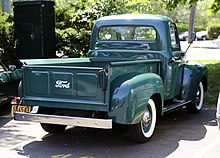 1951 Ford F-series, showing the larger rear window
1951 Ford F-series, showing the larger rear window
The F-Series was sold in four basic models. Along with the pickup truck (F-1 through F3), the F-Series was sold as a panel truck (based on the pickup), COE/cab-over engine chassis (F-5 and F-6, branded C-Series) and school bus chassis (F-5 and F-6, branded B-Series). Above the F-5, the F-Series was a medium-duty and heavy-duty conventional truck sharing the bodywork of the smaller F-Series.
The models are:
F-1: 1/2 ton (4,700 GVWR max.) F-2: 3/4 ton (5,700 GVWR max.) F-3: Heavy Duty 3/4 ton (6,800 GVWR max.) F-3: Parcel Delivery (7,000 GVWR max) & optional rear spring pkg (7,800 GVWR max.) F-4: 1 ton (7,500 GVWR max) & optional 1¼ ton pkg (10,000 GVWR max.) F-5: 1½ ton: Conventional, school bus, and cab over engine (C.O.E.) (10,000–14,500 GVWR) F-6: 2 ton: Conventional, school bus, and C.O.E. (14,000–16,000 GVWR) F-7: Conventional (17,000–19,000 GVWR) F-8: Conventional (20,000–22,000 GVWR)Variation by Year:
1948: Feature a wider, longer, and taller cabs. Model designations for trucks were badged as F-1s. 1949: The most noticeable change on the 1949 trucks was the deletion of the red pinstripes on the silver painted grille bars. Wheels were painted to match body color, rather than the previous black wheels. 1950: The standard three-speed shift was relocated from the floor to the steering column. 1951: The 1951 trucks were restyled with a single bar type grille and a headlight at each end of the grille bar. The grille was painted argent (silver) to complement the chrome headlight bezels. During the model year, the grille was painted ivory and the headlight rings argent (silver). The hood got new side spears and a three slot embellishment at the front. The front bumper was redesigned. A V-8 emblem was used on the upper grille support on corresponding trucks. The pickup bed and tailgate were redesigned. The bed used a hardwood floor instead of the previous all metal floor. The rear window was larger. Door panels were also added. 1952: The VIN plate was attached to the rear face of the driver's door. The information on the rating plate is the VIN number. The VIN number identifies the series, model year, assembly plant and production sequence. Powertrain[edit] Engines[edit] Engine Years Power Usage 226 CID Flathead 6 I6 1948–51 95 hp (71 kW) at 3,300 rpm F-1 through F-6 239 CID Flathead V8 1948–52 100 hp (75 kW) at 3,800 rpm F-1 through F-6 254 CID Flathead 6 1948–51 110 hp (82 kW) at 3,400 rpm F-6 only 337 CID Flathead V-8 1948–51 145 hp (108 kW) at 3,600 rpm F-7 and F-8 215 CID OHV Straight-6 1952–53 101 hp (75 kW) 279 Lincoln Y-block (EAL) 1952–55 145 hp (108 kW) at 3,800 rpm F-7 only 317 Lincoln Y-block (EAM) 1952–55 155 hp (116 kW) at 3,900 rpm F-8 only Transmissions[edit]All are manual.
3-speed light-duty, F-1 only 3-speed heavy-duty, F-1 through F-5 4-speed (spur gear), F-1 through F-6 4-speed Synchro-Silent, F-4 through F-6 5-speed overdrive, F-7 and F-8 5-speed direct drive, F-7 and F-8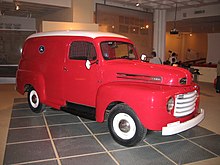 1948 F-1 used by Israel Postal Company in 1948–1949, now at Eretz Israel Museum, Philatelic Building
References[edit]
1948 F-1 used by Israel Postal Company in 1948–1949, now at Eretz Israel Museum, Philatelic Building
References[edit]
 Wikimedia Commons has media related to Ford F-Series (1948).
^ a b Gunnell, John A. (1993). Standard Catalog of American Light-Duty Trucks. krause Publications. ISBN 0-87341-238-9.
Ford F-Series production models and variants
Ford F-Series generations
Wikimedia Commons has media related to Ford F-Series (1948).
^ a b Gunnell, John A. (1993). Standard Catalog of American Light-Duty Trucks. krause Publications. ISBN 0-87341-238-9.
Ford F-Series production models and variants
Ford F-Series generations
Pickup Trucks(½–1 ton)
First generation (1948–1952) Second generation (1953–1956) Third generation (1957–1960) Fourth generation (1961–1966) Fifth generation (1967–1972) Sixth generation (1973–1979) Seventh generation (1980–1986) Eighth generation (1987–1991) Ninth generation (1992–1996) Tenth generation (1997–2003) Eleventh generation (2004–2008) Twelfth generation (2009–2014) Thirteenth generation (2015–)Super Duty (¾–1½ ton)
First generation (1999–2007) Second generation (2008–2010) Third generation (2011–)Medium-Duty Trucks(Class 5–7 Trucks)
F-Series "Big Job" (1951–1953, 1954–1957) F-Series "Super Duty/Extra Heavy Duty" (1958–1962) F-Series Medium Duty (1967–1979) F-Series Medium Duty (1980–1998) F-Series Super Duty (F-450/F-550; 1999–) F-Series Medium Duty (F-650/750; 2000–) Related models
Ford Bronco
Ford Expedition
Ford Excursion
Ford Super Duty
Lincoln Blackwood
Lincoln Mark LT
Lincoln Navigator
SVT Lightning
SVT Raptor
Related articles
Ford Atlas (2013)
Ford F-250 Super Chief (2006)
Ford B-Series
Hennessey VelociRaptor SUV
Hennessey VolociRaptor600
Mercury M-Series
Plasan/Oshkosh Sand Cat
Knight XV
Lenco BearCat
TAV Gurkha
Related models
Ford Bronco
Ford Expedition
Ford Excursion
Ford Super Duty
Lincoln Blackwood
Lincoln Mark LT
Lincoln Navigator
SVT Lightning
SVT Raptor
Related articles
Ford Atlas (2013)
Ford F-250 Super Chief (2006)
Ford B-Series
Hennessey VelociRaptor SUV
Hennessey VolociRaptor600
Mercury M-Series
Plasan/Oshkosh Sand Cat
Knight XV
Lenco BearCat
TAV Gurkha
 Category
Category
 Commons
Commons
 WikiBooks
WikiBooks
 WikiNews
« previous — Ford Motor Company light truck timeline, North American market, 1946–1979 — next »
Type
1940s
1950s
1960s
1970s
6
7
8
9
0
1
2
3
4
5
6
7
8
9
0
1
2
3
4
5
6
7
8
9
0
1
2
3
4
5
6
7
8
9
SUV
Bronco
Bronco
Coupé utility
Ranchero
Ranchero
Ranchero
Ranchero
Ranchero
Ranchero
Ranchero
Compact pickup
Courier
Courier
Full-size pickup
Standard/Deluxe
F-Series
F-Series
F-Series
F-Series
F-Series
F-Series
Van
Econoline
Econoline
Econoline / Club Wagon
WikiNews
« previous — Ford Motor Company light truck timeline, North American market, 1946–1979 — next »
Type
1940s
1950s
1960s
1970s
6
7
8
9
0
1
2
3
4
5
6
7
8
9
0
1
2
3
4
5
6
7
8
9
0
1
2
3
4
5
6
7
8
9
SUV
Bronco
Bronco
Coupé utility
Ranchero
Ranchero
Ranchero
Ranchero
Ranchero
Ranchero
Ranchero
Compact pickup
Courier
Courier
Full-size pickup
Standard/Deluxe
F-Series
F-Series
F-Series
F-Series
F-Series
F-Series
Van
Econoline
Econoline
Econoline / Club Wagon

-
Ford F-Series Trucks History
For more than two decades, Ford F-Series trucks were the best selling vehicle in the United States, and the F-150 (the series' half-ton truck) still retains a title it's held for over thirty years America's favorite pickup truck.
Today's lower-number truck sales are the result of escalating fuel prices and a dwindling economy, and not a reflection of the latest F-Series redesign. F-Series trucks still own an excellent share of the automotive market, and were popular with buyers during the U.S. government's Cash for Clunkers program, with 16,263 F-150s sold (versus the top selling vehicle, the Toyota Corolla at 29,488).
 Sicnag/Flickr
Ford F-Series Pickup Trucks: 1948-1952
Sicnag/Flickr
Ford F-Series Pickup Trucks: 1948-1952
In 1948, Ford introduced the F-Series, the first truly new pickup trucks since the beginning of World War II. Here's a look at the beginnings of the pickup truck that's since become Ford's all-time best selling vehicle. More »
 1954 Ford F-100 Truck. © Ford Motor Co.
Ford F-Series Pickup Trucks: 1953-1956
1954 Ford F-100 Truck. © Ford Motor Co.
Ford F-Series Pickup Trucks: 1953-1956
Ford revamped its F-Series pickup trucks in 1953 to coincide with the company's 50th Anniversary. Take a look back at the features early 1950s buyers found when they went shopping for a Ford truck. More »
 1959 Ford Truck Ad. © Ford
Ford F-Series Pickup Trucks: 1957-1960
1959 Ford Truck Ad. © Ford
Ford F-Series Pickup Trucks: 1957-1960
New additions to Ford's third generation F-Series trucks included the introduction of the first Styleside body in F-Series history, with a steel bed floor and a sleeker, more modern appearance.
F-Series power was boosted and Ford began producing its own 4WD trucks, no longer sending them out for conversion.
The Ranchero was introduced during this period, and Lee Iaccoca became Ford's Trucks Marketing Manager. More »
 1961 Ford F-100 Truck. Photo © Dale Wickell
Ford F-Series Pickup Trucks: 1961-1966
Ford made significant styling changes to its fourth generation F-Series trucks, tweaking the look from year to year. More »
1961 Ford F-100 Truck. Photo © Dale Wickell
Ford F-Series Pickup Trucks: 1961-1966
Ford made significant styling changes to its fourth generation F-Series trucks, tweaking the look from year to year. More »
 1968 Ford F-100 Ranger Pickup Truck. Photo © Dale Wickell
Ford F-Series Pickup Trucks: 1967-1972
The F-Series fifth generation brought along roomier trucks with better visibility and the introduction of new trim levels, including the "plush" Ranger edition. More »
1968 Ford F-100 Ranger Pickup Truck. Photo © Dale Wickell
Ford F-Series Pickup Trucks: 1967-1972
The F-Series fifth generation brought along roomier trucks with better visibility and the introduction of new trim levels, including the "plush" Ranger edition. More »
 1975 Ford Truck Ad. © Ford
Ford F-Series Pickup Trucks: 1973-1979
Ford made major changes to its sixth generation F-Series trucks, updating structure, appearance, power and comfort. More »
1975 Ford Truck Ad. © Ford
Ford F-Series Pickup Trucks: 1973-1979
Ford made major changes to its sixth generation F-Series trucks, updating structure, appearance, power and comfort. More »
 1980 Ford F-150 Truck. © Ford Motor Co.
Ford F-Series Pickup Trucks: 1980-1986
Better aerodynamics was a key element in Ford's 1980 F-Series redesign, and ramped up power provided better hauling and towing capabilities. More »
1980 Ford F-150 Truck. © Ford Motor Co.
Ford F-Series Pickup Trucks: 1980-1986
Better aerodynamics was a key element in Ford's 1980 F-Series redesign, and ramped up power provided better hauling and towing capabilities. More »
 1987 Ford F-150 Truck. © Ford Motor Co.
Ford F-Series Pickup Trucks: 1987-1996
1987 Ford F-150 Truck. © Ford Motor Co.
Ford F-Series Pickup Trucks: 1987-1996
Ford F-Series trucks from this period were all about change, from the first year of the re-design and throughout the period. Ford lead the way in anti-lock brakes, becoming the first to offer the feature as standard equipment on trucks.
Ford gave the F-Series somewhat of a facelift in 1992, but the changes weren't significant enough to call those pickup trucks a completely redesigned vehicle. More »
 1997 Ford F-150 Pickup Truck. Ford Motor Co.
Ford F-Series Pickup Trucks: 1997-2003
1997 Ford F-150 Pickup Truck. Ford Motor Co.
Ford F-Series Pickup Trucks: 1997-2003
Rounded styling gave 1997 Ford F-Series trucks a more modern appearance than trucks in preceding generations.
In 1997, SuperCab trucks received a rear opening half-door on the passenger side, followed by an identical door on the driver's side two years later.
Ford resurrected the SVT Lightning after a 3-year absence, and in 2001 the F-Series SuperCrew became the first half-ton pickup truck with four full doors. More »
 2004 Ford F-150 XLT, STX, Lariat, FX4. Ford Media
Ford F-Series Pickup Trucks: 2004-2008
2004 Ford F-150 XLT, STX, Lariat, FX4. Ford Media
Ford F-Series Pickup Trucks: 2004-2008
Ford added 2" to the bed sides on all F-Series trucks and lengthened its Standard and SuperCab models by 6". The lineup received a new engine that increased low-end torque and horsepower, but also improved fuel economy.
A new, fully boxed frame was introduced in 2004. That, and suspension changes, resulted in trucks with a better ride, especially on rough roads. Hydro-formed steel panels with additional built-in crush zones enhanced driver and passenger safety.
Ford made additional design changes during each of the this generation's four years. More »
 2009 Ford F-150 Pickup Truck. © Basem Wasef, About.com Guide to Motorcycles
Ford F-Series Pickup Trucks: 2009-
You'll find more comfort and safety features than ever before in Ford's newest generation F-Series trucks, along with components built for increased functionality. Take a look at some of the options and standard features on-board the most recent F-Series Trucks. More »
2009 Ford F-150 Pickup Truck. © Basem Wasef, About.com Guide to Motorcycles
Ford F-Series Pickup Trucks: 2009-
You'll find more comfort and safety features than ever before in Ford's newest generation F-Series trucks, along with components built for increased functionality. Take a look at some of the options and standard features on-board the most recent F-Series Trucks. More »

-
1948 ford f series | eBay
Enter your search keyword
All CategoriesAntiquesArtBabyBooksBusiness & IndustrialCameras & PhotoCell Phones & AccessoriesClothing, Shoes & AccessoriesCoins & Paper MoneyCollectiblesComputers/Tablets & NetworkingConsumer ElectronicsCraftsDolls & BearsDVDs & MovieseBay MotorsEntertainment MemorabiliaGift Cards & CouponsHealth & BeautyHome & GardenJewelry & WatchesMusicMusical Instruments & GearPet SuppliesPottery & GlassReal EstateSpecialty ServicesSporting GoodsSports Mem, Cards & Fan ShopStampsTickets & ExperiencesToys & HobbiesTravelVideo Games & ConsolesEverything Else
Advanced
-
1948 Ford F-Series Trucks - HowStuffWorks
Ford's top management knew full well how crucial the new 1948 F-Series truck program was to the company's long-range goals. Let's examine how Ford's 1948 truck line differed from the one it was replacing.
First of all, and critically important, Ford's truck range was substantially expanded. In 1947, the line consisted only of a 114-inch-wheelbase 1/2-ton series; a 122-inch-wheelbase one-ton series (called the Tonner); the Vanette, which was a forward-control delivery route van built on a modified Tonner chassis; and a heavy duty line of 11/2- and two-ton conventional cab and cab-over-engine models.
The 1/2-ton and Tonner series included finished pickup, panel, stake, and platform models, as well as chassis/cowl, chassis/windshield, and chassis/cab jobs adaptable to aftermarket conversions. The heavy duty lines were restricted to stake and platform bodies, and chassis/cowl, chassis/windshield, and chassis/cab models. A special 134-inch-wheelbase dump truck chassis with cab completed the offerings.
In contrast, the 1948 line consisted of eight levels, that is, 1/2-, 3/4-, heavy duty 3/4-, one-, 11/2-, two-, 21/2- and three-ton trucks. Only one panel model was now cataloged, in the light duty 1/2-ton range, but it gained a new body with a slightly longer cargo area than in the 1947.
The only commercial body types that didn't reappear in 1948 were the car-based sedan delivery and the Vanette. In the case of the former, Ford engineers were too busy with the bread-and-butter trucks to be distracted by a specialized, low-volume model. The latter was revived in 1949 as the Parcel Delivery chassis, an adaptation of the F-3 available on two wheelbases.
The engineers' second departure from past practices was the use of an engine not already in use in a FoMoCo car. (The only other time Ford used a non-auto engine in a truck -- transit buses excepted -- was in 1941 and 1942, when a 120-cubic-inch four-cylinder tractor engine was offered as an option for 1/2-ton trucks. But it was created by cutting Ford's famous 239-cubic-inch "flathead" V-8 automobile engine in two.) The new engine was a 337-cubic-inch L-head V-8, commonly known as the Lincoln engine because a version of it also powered Lincoln cars beginning in 1949. This big V-8 was responsible for putting Ford squarely in the heavy truck business.
Ford billed its 11/2- and two-ton trucks as "Heavy-Duty" models and the new 21/2- and three-tonners as "Extra Heavy-Duty" models. According to standard industry practice, they would have been classified as medium duties and heavy duties, respectively. Ford's terminology was perfectly acceptable, though, because compared to its other trucks, these were indeed heavy and extra-heavy duty vehicles.
The third new component in Ford's marketing strategy was a simple yet valuable and effective nominal size rating system. The trucks were badged F-1 (for the 1/2-ton models) through F-8 (for the three-ton jobs), the "F" having no more significance than to stand for Ford. The system indelibly stamped various gross vehicle weight (GVW) ratings in the minds of buyers, sellers, and users of Ford trucks. (At the time, the industry recognized seven standard weight classifications, instead of the eight currently in use.)
Ford's long-term goal was to overtake both archrival Chevrolet and International. Chevrolet was the industry leader in light duty and medium duty trucks, while International dominated in the higher end of the medium duty class and in heavy duties. Ford's F-1 through F-6 vehicles were aimed directly at Chevrolet, while the new F-7 and F-8 models targeted International. The idea was hardly original; Ford picked it up from International. But Dearborn's effective use of this model identification system was later duplicated by the rest of the industry.
Go to the next section to read about Ford's 1948 light-duty F-Series trucks.
For more information on cars, see: Classic Cars Muscle Cars Sports Cars New Car Search Used Car Search
-
The History Of The Ford F-Series In The 20th Century
First Generation 1948 - 1952
1948 - In January 1948, a new era began at the Ford Motor Company with the release of an all-new line of trucks that Ford dubbed the "F-Series."
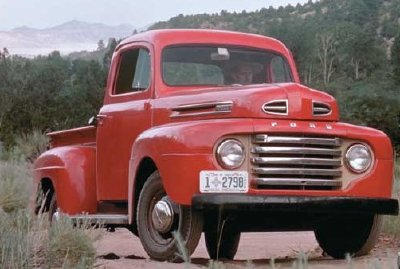
This new series, which Ford promoted as its "Bonus Built Line," covered a wide range of models with different cab and chassis combinations. The line started out with light-duty 1/2-ton-rated pickup trucks and ran all the way up to the Extra Heavy-Duty, three-ton-rated F-8. These trucks used a completely redesigned cab with all-new front-end sheetmetal. And in a departure from previous practice, the same cab served both conventional and Cab-Over-Engine models.
Along with the fresh styling given 1948 Ford trucks came new model designations; this 1/2-ton was labeled the F-1. Squared-off front fenders wrapped smoothly into the front fascia, which contained a prominent horizontal-bar grille. Rear fenders were styled to match the profile of the fronts. Also new was a one-piece windshield.
1951 - Ford trucks received a number of revisions for 1951. Restyled for the first time since their 1948 debut, Ford's F-Series received modified front fenders, grille cavity, and grille. Also changed were the hoods and cabs, along with the dashboard and rear window, which was now substantially larger for better visibility.
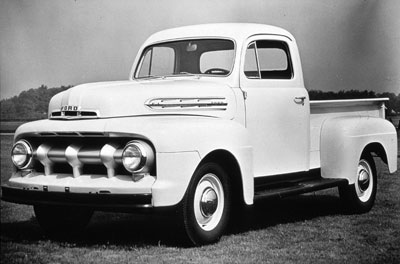
Also for 1951 -- and for the first time since the late 1930s -- Ford offered truck buyers two levels of cab trim: the standard Five Star Cab and the deluxe Five Star Extra Cab. The latter came with such niceties as foam seat padding, extra sound-deadening material, bright metal trim around the windshield and vent windows, an argent-finished grille bar, locks and armrests on both doors, two-toned seat upholstery, a dome light, and twin horns.
Pickup beds now had a wood floor rather than steel, and note the larger rear window that accompanied the 1951 redesign. As advertised on its nose, this truck carries Ford's 239-cubic-inch flathead V-8, still rated at 100 horsepower.
1952 - Ford truck styling was altered little for 1952, with the most noticeable change affecting the nose and side trim on the trucks' hoods. Beneath the hood was a different story, however, as a new six-cylinder engine boasting overhead valves was introduced. Sized at 215 cubic inches, it produced 101 horsepower, six more than the 226-cid flathead six it replaced. The flathead V-8 continued to be used in Ford pickups as before, although cars and heavy-duty trucks offered overhead-valve V-8s.
Second Generation 1953 - 1956
1953 - Ford Motor Company celebrated its Golden Anniversary in 1953 by introducing a totally redesigned line of F-Series trucks. It was the first redesign of the truck since 1948. 1953 trucks received a longer hood that flowed into the front fenders, along with horizontal grille bars. Cabs were also new, boasting more glass area. Instead of calling these trucks the "Bonus Built" models, as they had been from 1948 to1952, Ford now referred to them as the "Economy Truck Line." Joining the new name was a new hood emblem: a gear cog bisected by a lightning bolt below the Ford script. And for the first time in Ford-truck history, an automatic transmission was offered as an option, though initially only on F-100s. This would prove to be the final year for the flathead V-8.
The company also took this opportunity to change its model designations, adding "00" to the end of the existing monikers. Thus the F-1 became the F-100, and so on. These designations are still used today.
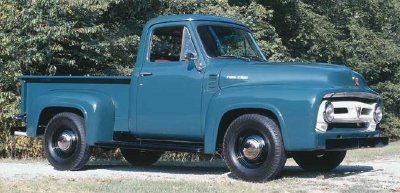
1954 - The 1954 model year brought the end of Ford's famous flathead V-8 engine, replaced in trucks that year by the overhead-valve V-8 already two years old in Ford's car line. Referred to as the "Y-Block" engine, it displaced the same 239 cubic inches as the flathead, but produced nearly 15 percent more horsepower. Also for that year, the automatic transmission option was expanded to include F-250 and F-350 trucks.
Another grille change marked Ford's 1954 trucks, this time adding a pair of prominent vertical guards. The V-8 badge on the grille indicates this pickup has Ford's new overhead-valve V-8. At 239 cubic inches, displacement was the same as the flathead's, but horsepower rose from 110 to 130.
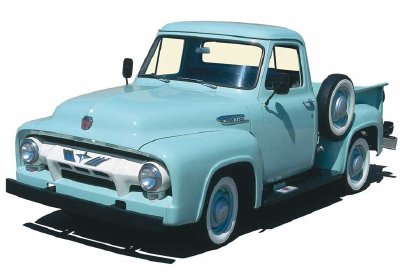
A cross in the center of this 1954 Ford F-100's grille (above) indicates that the truck carries the revised six-cylinder engine Ford issued for 1954. A bore increase brought it up to 223 cubic inches and 115 horsepower from 215 cid/101 hp.
The six chrome hash marks that flank the cross indicate this is a Deluxe model, which had fancier trim. Adopted with the 1953 redesign (and featured on this vehicle) was a new hood badge featuring a lightning-bolt/gear-wheel motif below the famous Ford script.
1955 - Yet another change to grille design differentiated the 1955 Ford trucks from the 1954s. The vertical guards were dropped in favor of a V-shaped dip in the upper bar, which again carried an indicator of a six-cylinder or V-8 engine. Less obvious were the switch to tubeless tires on F-100s and the newly optional power brakes. Not surprisingly, the F-100 with the 6-1/2 foot bed was Ford's most popular truck in 1955.
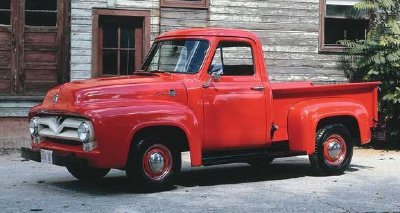
1956 - In an effort to match the redesigned Chevrolet trucks that had appeared for 1955, Ford attempted to modernize its F-Series trucks by giving them wraparound windshields and restyled dashboards. Ford's 1956 truck grilles got the customary annual update, and now boasted a "Back to the Future" look very similar to that of the 1953 Ford truck models.
Third Generation 1957 - 1960
1957 - Ford's F-Series trucks now sported a completely new look that was more square and modern, while at the same time featuring a wider cab, hidden running boards, flush-mounted front fenders, and a wider, full-width hood. The 1957 model year also brought a choice of two pickup beds: the traditional Flareside, with a narrow bed and attached rear fenders, and the new Styleside, with straight-through fenders. A straight-sided bed was nothing new to the industry, but unlike other manufacturers, Ford offered its Styleside pickup box at no extra charge. pickup beds were offered in 6-1/2 and 8-foot lengths for the 1957 Ford F-Series trucks. Engine choices included a 223-cubic-inch six, with 139 horsepower, and a 272-cid V-8 with 171 hp.
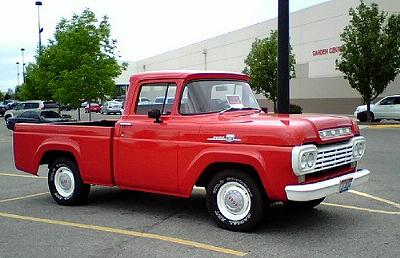
(No, 1957 F-100's did not come with white letter tires)
1958 - nearly all Ford trucks were restyled to accommodate quad headlights. For the F-Series trucks, that meant a restyled grille -- which they had been getting every year anyway. But the big change -- literally -- was a new line of heavier-duty model trucks called Super Duty, which came equipped with new V-8 engines of up to a whopping 534 cubic inches. By this time, interiors were beginning to show some style themselves, with contoured dashboards and car-like instrument panels.
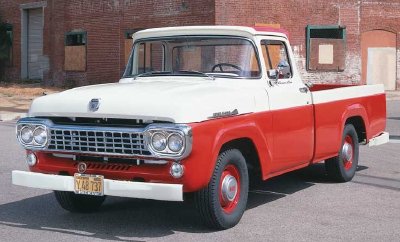
1959 - For the first time in Ford history, a light-duty truck buyer could buy a factory-built 4x4 Ford truck. Previously, Ford trucks had been converted to four-wheel drive by outside manufacturers such as Marmon-Herrington, Napco, or American-Coleman. Although more buyers still chose the 6-1/2 foot bed for their F-100 trucks, the 8-foot bed was gaining in popularity and would eventually surpass its shorter sibling in sales. Likewise, the smooth-sided Styleside bed sales would soon top those of the "traditional" Flareside.
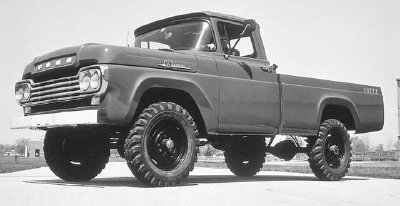
1960 - Ford trucks would have the same body for 1960, but the grille would extend down to the bumper and was joined by slots in the hood's leading edge.
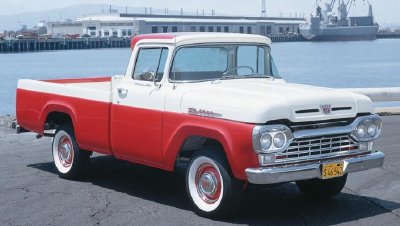
Fourth Generation 1961 - 1966
1961 - Ford F-100 Styleside pickup beds were integrated with the cabs in an F-Series redesign for 1961. Traditional Flareside beds continued to be offered as well, and both styles were available in 6-1/2 and 8-foot lengths.
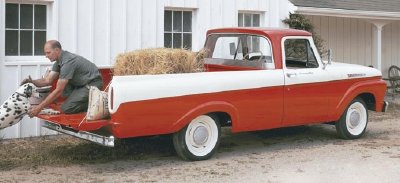
1962 - The Ford F-Series' grilles were slightly revised for 1962, replacing the FORD lettering in the middle with cross bars. Also for 1962, F-Series Styleside 4x4s came with a separate cab and bed, as shown here.
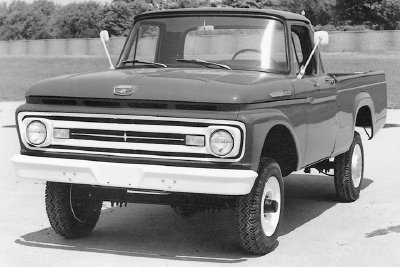
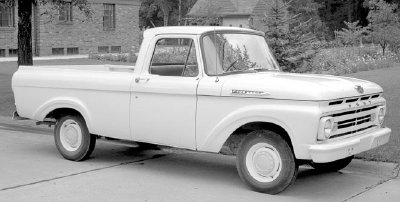
The cab and bed remained integrated on 1962 F-Series 4x2 models (as shown here), although these trucks also would offer the separate cab and bed by midyear.
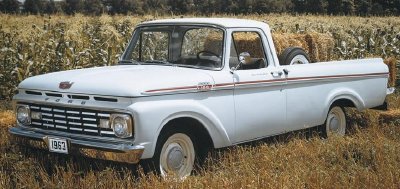
1963 - The 1963 F-100s were offered with three different bed designs: a separate Styleside; a traditional Flareside; and a Styleside integrated with the cab, a version that would be dropped after 1963.
1964 - 1964 brought a separate box for Styleside models, rendering the "unibody" pickup trucks a thing of the past. Also new was a brace of gas engines for the medium and heavy-duty Ford truck lines.

Grilles changed a bit on the popular Ford F-Series trucks in 1964, as shown on this F-250 4x4, which sports an eight-foot Flareside bed.
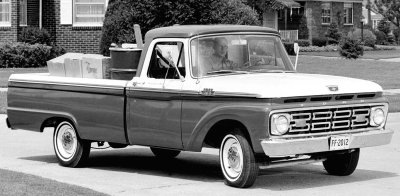
By 1964, an F-Series pickup could be fitted with such car-like features as two-tone paint and air conditioning.
1965 - In 1965, the Twin I-Beam front suspension was introduced with coil springs.
The 1965 and 1966 trucks have a "TWIN I-BEAM" emblem on the front fender.
It was offered only on light-duty two-wheel-drive F-Series pickup trucks, giving them a softer ride and better handling characteristics. Also in 1965, the name "Ranger" is first introduced as a styling package for the F-Series pickup trucks.
Ford started offering a 4-door crew cab on the F-250 and F-350 in 1965. Before 1965, Ford farmed out trucks to a number of coachworks across the country to convert the regular cab trucks to crew cab trucks. These trucks were sold at the Ford dealerships (or even directly through Ford for large orders of vehicles) and many of them still carried a Ford warranty since they were authorized builds. Ford, however, never actually started normal in-house production until 1965.
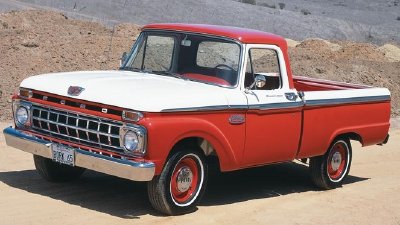
1966 - A restyled grille was the only change of note to the 1966 F-series pickup trucks. This restored example boasts upscale Custom Cab trim.
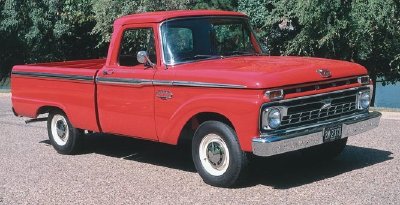
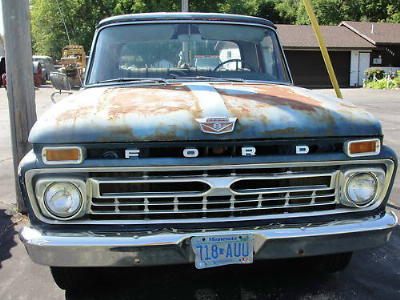
Fifth Generation 1967 - 1972
1967 - Ford's F-Series trucks were restyled for the 1967 model year, although the extra-heavy-duty models still used the earlier 1961-1966 cab and front sheetmetal.
1968 - In 1968, federal regulations required all automotive manufacturers to add side marker reflectors or lights, so Ford redesigned the hood emblems to incorporate reflectors.
(Side marker reflector on hood)
The same year the trucks received larger versions of Ford's FE engine family with the introduction of the 360 and 390 cubic inch engines. Also changed for 1968 were the heater controls, arm rests, interior door handles and window cranks, and the upper trim moulding on models so equipped. Rear side marker reflectors were also added to the lower bed side panels in 1968, per government regulations.
1969 - A Contractors Special package was offered on 1969 Ford F-Series pickups, which included side boxes for the bed and an optional underhood 110-volt generator. F-Series grilles were changed only slightly for 1969.
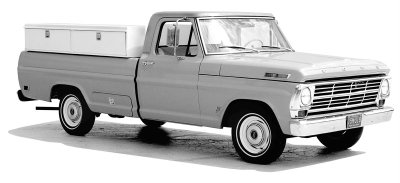
1970 - The gradual push toward comfort and luxury in light trucks gained added momentum at Ford with the arrival of Ranger XLT trim for certain F-Series models. The Ranger XLT was the top trim package with Ranger, Sport Custom and Custom rounding off the rest of the line. XLT equipment bested Ranger gear with items like a woodgrained tailgate appliqué, full-length lower-body moldings, cloth-and-vinyl upholstery, carpeting, and other conveniences. This 1970 Ford F-100 Ranger XLT also sports an extra-cost vinyl roof covering.
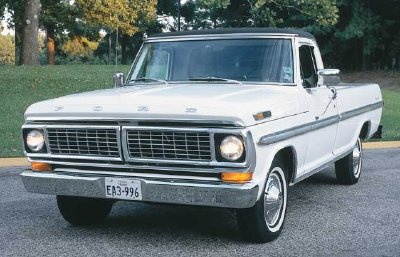
The 1970 Ford F-Series Ranger with four-wheel drive rode high off the ground. A chrome front bumper was newly standard on Ford pickup trucks.
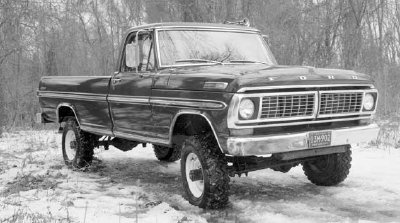
1971 - Other than minor trim updates, the 1971 Ford truck lineup was little-changed from 1970. Ford concentrated instead on its new subcompact Pinto and a redesigned Mustang.
1972 - The extremes of the 1972 1/2-ton F-100 range: a full-dress Ford Explorer (trim package added this year) with lots of bright trim and colorful upholstery...
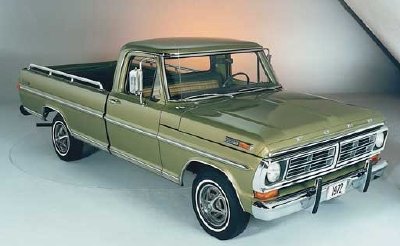
...and an all-business entry-level 1972 Ford Custom.
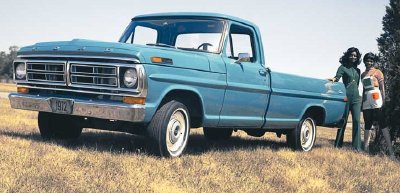
Four-wheel-drive Ford F-250s got a beefier Spicer front axle for 1972.
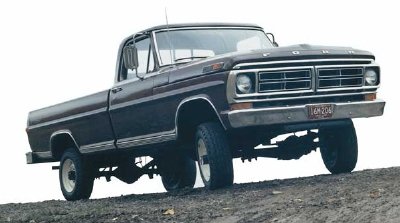
Sixth Generation 1973 - 1979
1973 - The truck was redesigned in 1973; the grille for the 1973 model year featured two silver-metallic plastic inserts divided by an aluminum bar that was part of the main grille frame, with the letters "F O R D" spaced out in a thin rail in the upper part of the grille. Large round headlights were on either side of the grille with the park/turn signal lamps placed above in the same rail where the "FORD" lettering was. The new cab design incorporated behind-the-seat storage for incidental items.
In 1973, a new model was offered, the F350 SRW (single rear wheel) pickup. These were a new heavy duty pickup with contractors and camping enthusiasts in mind. The trucks rode on a longer wheel base chassis but were the same overall length as an F250 pickup. If you ordered the Camper Special package on an F350 SRW it became a Super Camper Special which was designed for the much heavier slide-in campers coming on the market at that time.
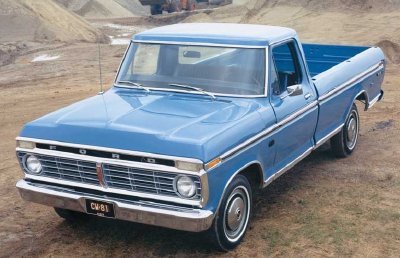
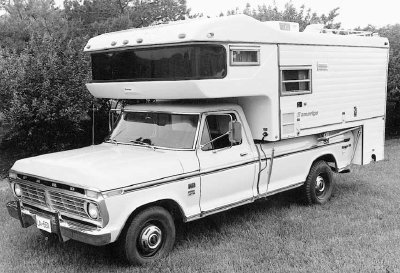
1974 - New for the F-Series that year was its first extended cab. The 22-inch-long extension was large enough to accommodate an optional forward-facing bench or side-facing jump seats. This was Fords response to Dodge's 1973 extended cab.
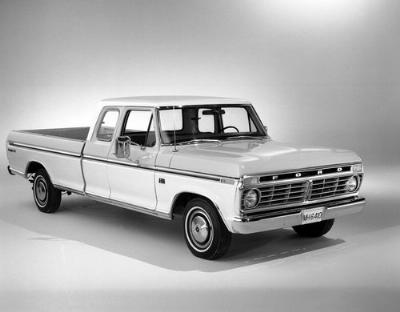
1975 - The F-Series pickup line changed little for 1975, with one exception: added was an F-150 model, which was intended to split the difference in payload capacity between the F-100 and F-250. Although hardly a major event at the time, the Ford F-150 would eventually take over from the F-100 as Ford's base full-size pickup, and it would go on to become the best-selling vehicle in the United States.
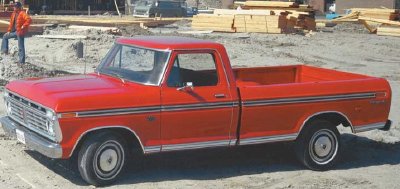
1976 - In 1976, the F-series became the best-selling truck in America, a position it has continued to hold since. This generation is noted for the durability of the body panels as Ford used extensive amounts of galvanized sheet metal to fight corrosion.
The first styling facelift to the 1973-generation Ford F-Series light-duty trucks showed up for 1976, when a new grille and squarish headlamp bezels appeared. F-100s with four-wheel drive, like this long-bed Ranger XLT, came with a standard 360-cubic-inch V-8 engine and four-speed transmission.
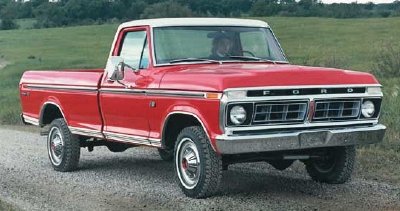

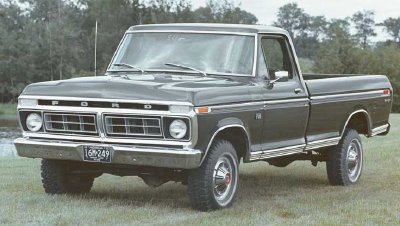
1977 - Although touched on only lightly in the 1977 F-Series pickup truck catalog, four-wheel-drive models were attracting enough interest to warrant a brochure of their own. image. 1977 was the first year for smaller cowl insignias moved near the windshield.
A Ford F-100 "Shorty Flareside" with four-wheel drive shows off the flashy graphics and abundant accessory choices that were aimed at younger buyers who wanted to personalize their trucks. The 117-inch-wheelbase Flareside featured a 6-1/2 foot cargo bed.
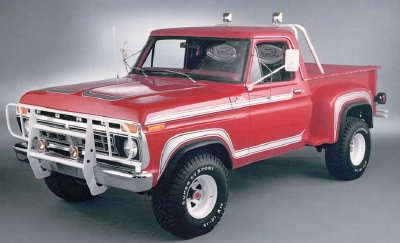
1978 - In 1978, the round headlight design was retained for the regular Ranger and Custom trim levels. The XLT and "Lariat" trim level incorporated rectangular headlights with optional chrome headlight doors and chrome grille insert. The split grille design was overhauled in favor of a single-piece grille insert design. The headlights were also placed in a more stylized "insert" themselves, and the park/turn signal lamps were now placed below the headlights. A luxury Lariat trim was also introduced for 1978.
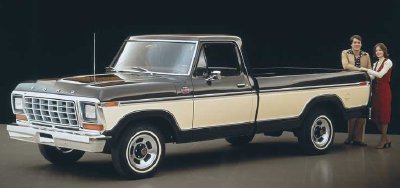
1979 - Ford's 1979 model year brought a new promotional campaign for trucks: the famous "Built Ford Tough" slogan. The round headlights were replaced by rectangular headlamps across all the trim levels and the surrounding grille insert that framed the headlamps was now available in either black, or chrome to match that of the aluminum grille frame. Additionally, an optional chrome-plated "F O R D" letterset could now be seen on the hood immediately above the grille.
A 1979 Ford F-150 Ranger Lariat could get optional Combination Tu-Tone paint and bright box rails.
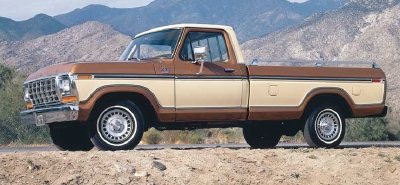
A two-wheel-drive 1979 Ford F-150 Ranger XLT Super Cab shows its length.
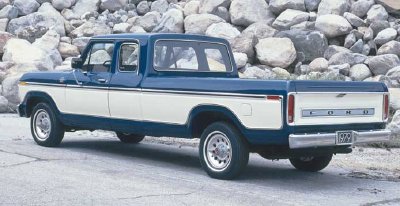
Seventh Generation 1980 - 1986
1980 - F-Series pickups got a new face for 1980, and pickup trucks continued to offer both Styleside and Flareside beds. Bronco and F-Series four-wheel-drive truck models adopted Twin-Traction Beam independent front suspension for 1980. Rival GM 434s wouldn't get independent front suspension until 1988.
(Ford Twin Traction Beam suspension - shown with aftermarket lift)
1981 - In 1981, all Ford truck lines carried over virtually unchanged, although Ford added the F-100 option with a "downsized" 255-cubic-inch V-8 engine. Smaller than even the standard 300-cubic-inch six, this engine may have been more marketing hype than fuel-economy help, but it showed Ford's commitment to increasing gas mileage.

F-Series Ford trucks had long received an annual styling update -- even if it only amounted to a slight change in the grille -- but that practice ceased with the 1981 models, which were virtually identical to 1980's. By this time, the Ford F-Series was on a roll as the best-selling truck in the land, so there was little incentive to mess with success. Besides, the 1980-81 was a good-looking design, as evidenced by this two-tone F-150 Flareside.
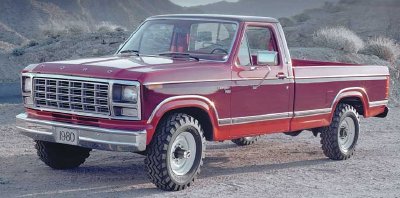
Several custom decor packages were available for light-duty pickups in the early Eighties, one of which included the two-tone paint and white-painted wheels shown here.
Flareside beds, once considered more utilitarian than the smooth-sided Styleside versions, were now considered more stylish. This Ford truck illustrates another example of the custom-decor packages available in 1981.
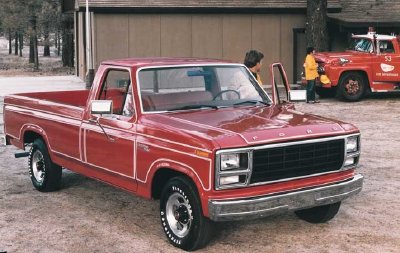
(This customized 1981 Ford truck features a blackout grille and aluminum wheels.)
In 1980 and 1981, the trim packages were:
Custom- Base model with manual locks/windows, vinyl seat, and black rubber floor mat.
Ranger- Intermediate trim that added a color-keyed floor mat, extra chrome, and woodtone dash trim.
Ranger XLT- A step up from the Ranger that added better seat trim, a color-keyed headliner, color-keyed carpeting, aluminum tailgate trim and optional power windows/locks.
Ranger Lariat- a step above the XLT that added a plusher interior.
1982 - Ford introduced a mildly restyled front end for F-Series pickup trucks. The Ranger trim line was dropped from the F-Series in 1982, since that name was to be applied to the new Ford Ranger compact pickup, which replaced the Ford Courier mini-pickup line. Trim options became XL, XLS, XLT, and XLT Lariat.
The 1982 F-series differed in appearance from an ´81 courtesy of a Ford blue oval that was placed in the center of a grille with fewer vertical bars. This prompted the deletion of the Ford lettering that previously graced the leading edge of the hood. In a further bow to fuel economy, the F-100 came standard with a new 232-cubic-inch V-6 for 1982.

SuperCab Ford trucks had a longer cab that allowed for a three-passenger rear bench seat or a pair of jump seats. The divided rear side window first appeared in Ford trucks for 1980.
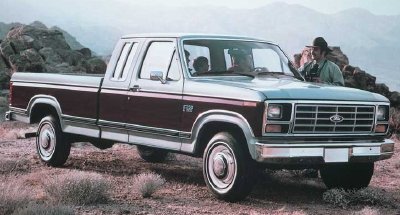
Spoked wheels and tape stripes continued to dress up F-Series trucks, with some new designs being offered for 1982. During this time, pickups were becoming more popular for regular passenger use, largely replacing high-performance cars -- long since regulated out of existence -- as trendy transportation.
For 1982–1986 the trim packages were:
Base - basically the same as the Custom of the previous years.
XL - replaced the intermediate Ranger trim for 1982 as the Ranger name would be used for Ford's new compact truck.
XLS- a new trim level that featured a blacked-out grille, bumpers, headlight bezels, and windshield trim. It also featured a stripe graphics package and black and silver dash trim. Available exterior colors were red, silver, and black.
XLT Lariat- featured floor carpeting, color-keyed headliner, a standard chrome grille, and optional power windows/door locks. In 1985 the tailgate trim was changed to a "flat" full width aluminum with a red "reflector" towards the bottom with chrome FORD letters.
Explorer - Was basically a step up from the XL line. The "Explorer" trim line received a higher geared rear end, an AM/FM radio, Chrome bumpers, Chrome fender well trim, and a chrome grill. The Explorer Line would later be dropped to introduce the Ford Explorer SUV in 1991.
1983 - Among F-Series pickups, only the F-350 was available in a four-door, six-passenger crew-cab body style for 1983. All 350s also came with an eight-foot bed, meaning the truck pictured above stretched more than 237 inches -- just shy of 20 feet -- bumper-to-bumper.
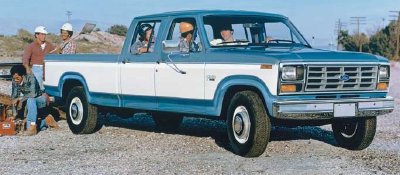
1984 - The F-100 was dropped as the base model at the end of 1983 and the now-familiar F-150 took its place as the base model F-Series truck for 1984. The Ford F-100's GVW rating put it below the threshold that allowed heavier pickups to get by with meeting "looser" truck emission standards, the model was unceremoniously dropped for 1984 -- after 30 years on the market. With that, the F-150 became Ford's base full-size pickup truck. Options included Explorer special-value packages that provided numerous uplevel features at a discounted price.
This was more of a historical loss than a sales one, as the slightly beefier F-150, which had been introduced in 1975, absorbed those buyers -- as evidenced by the fact it would soon become the nation's best-selling full-size pickup, and soon after the best-selling vehicle of any type.
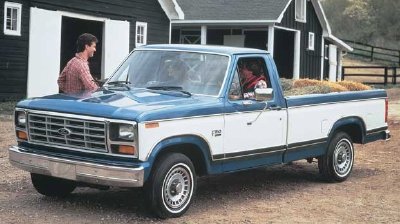
1985 - Ford F-Series pickups offered an optional fuel-injected 5.0-liter engine for 1985, and F-350 crew cab trucks got a dual-rear-wheel option, but otherwise the line saw few changes. Other gas engines in Ford trucks remained carbureted.
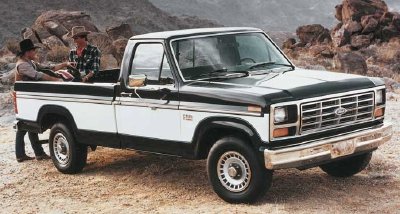
1986 - With the F-150 firmly ensconced as the best-selling vehicle in the U.S., there was little reason to change it for 1986 -- and Ford didn't.
Eight Generation 1987 - 1991
1987 - A new front end featured flush headlights (which required only the bulb, not the whole headlight to be replaced), wraparound parking lights and a simple grille with 12 rectangular openings. New front fenders, hood and bumper added to the new, more streamlined look. A revised instrument panel had more legible gauges and a bigger glove box. Maintenance was made easier via an easy-access fuse box and simplified belt replacement for the alternator, power steering pump and A/C compressor. Safety took a leap forward with antilock rear brakes, as Ford was the first company to make this feature standard on trucks. The 4.9-liter inline six received fuel injection and a healthy 20 percent increase in output, for a total of 150 horsepower. And later in the year, the 7.5-liter V8 also benefited from the fitment of fuel injection.
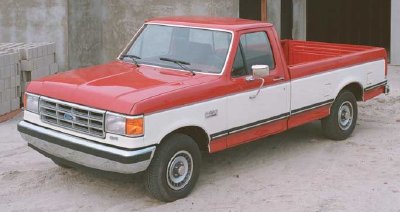
1988 - A new line of Super Duty Ford F-350 trucks was introduced for the 1988 model year. These trucks filled a gap between the regular F-350s and the medium-duty F-600s. Standard was a 7.5-liter V-8 engine, while a 7.3-liter diesel was optional.
F-Series also dropped its available Flareside bed, although it would return a few years later, meaning all pickups carried the Styleside bed shown on the F-150 pictured below.
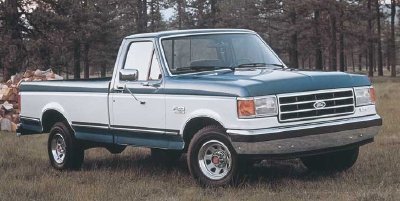
All engines now boasted fuel injection, but otherwise, the F-Series was little-changed after its 1987 facelift.
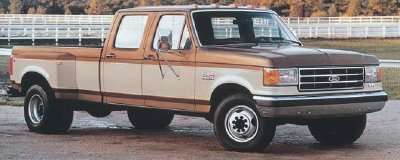
F-350s were offered with GVW ratings of up to 14,500 lbs. for 1988, made possible with the addition of available four-wheel disc brakes, heavy-duty axles, and 16-inch wheels. The optional diesel V-8 grew from 6.9 liters to 7.3.
1989 - Two-wheel-drive versions of the 1989 F-150 wore "EFI" (Electronic Fuel Injection) badges below the left-side headlight as shown above. Four wheel drive improvements included the addition of automatic locking hubs for the F-150 in 1989.
Expanded availability of the four-speed automatic transmission to heavy-duty two-wheel-drive models was the only change of note to Ford F-Series pickups for 1989.
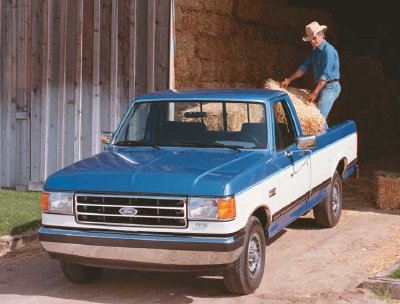
Four-wheel drive versions of the 1989 F-150 had a "4x4" badge below the left headlight, as shown above.
The F-Series was established as the nation's best-selling vehicle,
1990 - 1990 was the year of the Package. A heavy-duty service package, ideal for snowplow operators, consisted of a heavy-duty battery, high-capacity radiator and skid plates. And a sport appearance package included fancy wheels and a large tape stripe adorning the pickup's flanks. An electronically controlled, four-speed unit was now offered which promoted better fuel economy and reduced engine wear
1991 - Automatic hub locks were made standard for F-250 and F-350 trucks for 1991. And as with the F-150 the year before, the manual hubs were optional. Helping to make the transition from two-wheel to four-wheel drive even easier was an optional (on models with the 5.0-liter V8/automatic overdrive transmission) "Touch-Drive" electronic transfer case control that put the truck into four-wheel drive with the press of a dash-mounted button. Two-sided galvanized steel was adopted for the hood, tailgate and doors to help fend off body cancer (rust). The oddly named "Nite" package debuted this year as an option for the XLT Lariat and featured blackout trim, alloy wheels with 235/75/15 white-lettered tires, sport suspension and the obligatory decals.
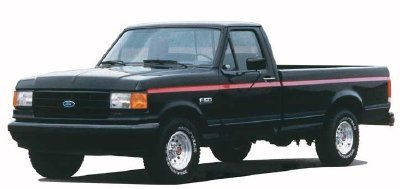
(rename 1991 F-150 Night)
Ninth Generation 1992–1996/1997
1992 - Ford F-Series pickups were also treated to a front-end restyle for 1992 that resulted in a smoother face. The F-Series received a smoother nose that had the front light clusters and bumper ends angled back slightly. "Aero" mirrors and a revised tailgate completed the fresh look. A new instrument panel contained easier-to-use controls and a power point. Plusher seats and door trim made the interior more inviting, and SuperCab models offered a large, optional console in addition to standard three-point rear seatbelts. And after a four-year hiatus, the Flareside version returned in 1992.

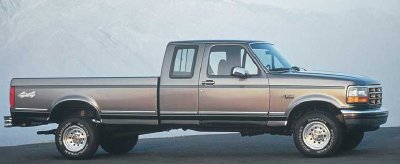
1993 - Replacing the Ford F-150's Nite package for 1993 was the performance-oriented Lightning, which lived up to its name with a special version of the 5.8-liter V-8 engine packing 240 horsepower, vs. 200 for other 5.8s. Like the Nite, Lightning featured blackout trim, to which was added a sport suspension with 17-inch alloy wheels, front spoiler, and specific bucket seats.
The Custom model was dropped, as the XL became the new base model. The Sport Appearance was also axed. Raising the seat cushion and adding padding improved rear seat comfort in SuperCab models.
(Ford F-150 Lightning)
1994 - Light-duty F-Series pickups got a driver-side airbag for 1994, but there were few other changes of note. Safety upgrades took place for 1994 when a driver's side airbag (except on heavy-duty models), side door beams and a high, center-mounted third brakelight debuted. A couple of new options showed up this year: a CD player and a 40/20/40 front seating arrangement that had a center seat which converted to an armrest with a built-in storage compartment and cupholders.
1995 - 1995 saw the the introduction of the Eddie Bauer edition. Named after the outdoor gear and apparel company favored by yuppies, the Eddie Bauer F-Series was the most luxurious Ford pickup available, with features such as two-tone paint, air conditioning, power everything, stereo with cassette, alloy wheels and the 40/20/40 front seat. A new 7.3-liter, "Power Stroke" turbodiesel became optional on F-250 Heavy Duty pickups and F-350'. This new direct-injection turbodiesel engine produced 210 horsepower and a whopping 425 pound-feet of torque -- both up significantly over previous versions. Matched to a four-speed automatic gearbox, the new engine put out 210 horsepower and 425 foot-pounds of torque, making it ideal for heavy hauling and towing applications.
1996 - Ford F-Series pickup trucks continued with few changes for 1996. F-150 Flareside and Lightning models met their demise and shorter-wheelbase versions of the F-250 Heavy Duty SuperCab and Crew Cab debuted. The short-wheelbase versions had a bed length of 6.75 feet versus the 8-foot bed of the longer-wheelbase trucks.
1997 - Arriving in the 1997 Ford trucks lineup was a completely redesigned full-size truck that featured the most radical changes yet seen from one generation of Ford pickups to the next. Introduced early in the 1996 calendar year, only certain models of the new F-Series trucks were offered at first, so some versions of the 1996-style trucks continued to be sold alongside them.
Among others, these included all the heavy-duty pickups (Ford F-250 HD and F-350), which wouldn't be redesigned until the 1999 model year. Among the Ford F-Series' many early accolades was the coveted Truck of the Year award from Motor Trend magazine
In its most radical change since 1980, the F-Series was redesigned for 1997. At first offered only in F-150 form -- and even then with a limited lineup -- it arrived early in the 1996 calendar year and was sold alongside the 1996 models. Both Flareside (shown here) and Styleside beds were available.
Early production focused on SuperCab (extended cab) versions, which featured a rear-hinged back door on the passenger side. These were sometimes called "half doors," as they were smaller than conventional ones. Also, they hinged at the rear and could only be opened after the corresponding front door was opened.
As production ramped up, regular-cab versions of the Ford F-150 truck became more plentiful. Grilles came in either body color (as shown here) or chrome, depending on trim level. Power came from a trio of new engines: a 4.2-liter overhead-valve V-6, and overhead cam V-8s of 4.6 and 5.4 liters. All produced more horsepower than the larger engines they replaced.
Trim levels consist of base XL, midlevel XLT and plush Lariat.
Ford didn't waste any time entering the sleek new F-150 in the NASCAR Craftsman Truck Series.
Tenth Generation 1997 - (2004)
1998 - Ford Motor Company reached a milestone in 1998 when it celebrated the 50th anniversary of the F-Series brand. The NASCAR F-150 marked the Golden Anniversaries of both the stock-car racing association and Ford's F-Series pickups. The dual side exhausts shown on this prototype were moved to the rear on production versions.
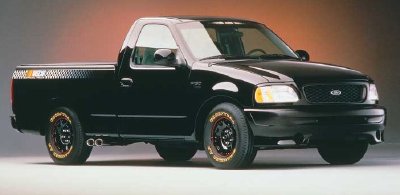
Ford didn't let the 50th Anniversary of the F-Series pass unnoticed, with numerous promotions depicting the inaugural 1948 version beside a new 1998 model.
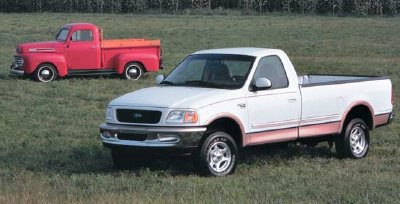
1999 - Midway through the 1998 model year, Ford finally introduced new heavy-duty F-Series pickup trucks based on the redesigned light-duty versions that had appeared for 1997. Tagged as 1999 Ford truck models, the F-250 HD and F-350 carried a similar but brawnier look, befitting their load-lugging status.
Returning in 1999 after a three-year hiatus was the high-performance Lightning truck, and it returned with a vengeance. Again based on the Ford F-150, it now carried an exclusive supercharged version of the 5.4-liter V-8 packing a mighty 360 horsepower. As before, a lowered sport suspension and special trim was included in the package.
Also in 1999, a loaded "King Ranch" edition with two-tone paint and a cabin that would make a Texan proud with its abundance of saddle leather trim was introduced.
Ford F-250 Heavy Duty and F-350 had lost out when the lighter-duty F-Series models were redesigned for 1997, but these trucks made up for it with a redesign of their own for 1999. Now called Super Duty, they arrived early in the 1998 calendar year, and like their lighter-duty linemates, offered a SuperCab with dual rear-hinged back doors. Styling touches included grilles incorporating vertical "nostrils" at each edge.
The 1999 Super Duty F-250 HD and F-350 also were available in crew cab form with four conventional side doors. Engine choices ranged up to a 6.8-liter V-10 with 275 horsepower, and a 7.3-liter V-8 turbodiesel with 235 hp and a stump-pulling 500 pound-feet of torque.
New for SuperCab versions of the F-150 were dual rear doors; previously, only the passenger side had a rear door. Other changes for 1999 included a revised grille and 25 more horsepower for the available 5.4-liter V-8, now with 26.
In 1999, the Ford Super Duty line included even heavier-duty F-450 and F-550 truck models that could be fitted with a variety of bed styles.
With the addition or redesign of several important vehicles and the deletion of its long-standing heavy-duty truck lines, it can never be said that Ford didn't close out the 20th century with a bang. In combination, these changes helped position the company for the next century -- and its second hundred years.
HELP WANTED: Want to contribute your articles/photos to this site? Click HERE.
© 2010 Blue Oval Trucks - 959 Media LLC - All Rights Reserved
'Blue Oval Trucks' and its logo are Service Marks of Blue Oval Trucks and are owned by James Oaks Enterprises LLC.
'Blue Oval Trucks' is an enthusiast site and is in no way affiliated with the Ford Motor Company

1948-1955 Ford F-Series rear center drive shaft seal 01T-4833 http://t.co/0LhBJZhWM7 http://t.co/D9BrsdCdkg 08/18/15, @sancheztadeo6
1948-1952 Ford Pickup Truck cowl mount RADIO ANTENNA , All F series http://t.co/4qV2hbYA2N http://t.co/T40GMZzLNY 08/18/15, @enriquevlljo
1948-1952 Ford Pickup Truck cowl mount RADIO ANTENNA , All F series http://t.co/1U4psr7Gd8 http://t.co/qdpZxMYeKI 08/18/15, @webbbrentwebb
1948-1952 Ford Pickup Truck cowl mount RADIO ANTENNA , All F series http://t.co/bISctNdDWc http://t.co/vKP4VhsNj1 08/18/15, @JustineMannbp
Comfortable, and fast with some problems. 1948 Ford F1 pickup truck Ford's legendary F Series began in... http://t.co/bg7B6qzDhn 08/18/15, @JouhnBrado
Complete Book of Classic Ford F-Series Pickups: Every model from 1948-1976~NEW! http://t.co/FMgkWjFkcY http://t.co/TMx6wr3Dco 08/17/15, @sancheztadeo6
1948-52 Ford Pickup Truck SUN VISORS - BLACK F-1, ALL F SERIES TRUCKS http://t.co/X84TyduO9d http://t.co/7wY1nvo4KW 08/17/15, @JustineMannbp
1948-52 Ford Pickup Truck SUN VISORS - BLACK F-1, ALL F SERIES TRUCKS http://t.co/ur7tUezevF http://t.co/Tc7gZnjg63 08/17/15, @ProductLavish
1948-52 Ford Pickup Truck SUN VISORS - BLACK F-1, ALL F SERIES TRUCKS http://t.co/GHaVsj454C http://t.co/sQoRRmHGMX 08/17/15, @webbbrentwebb
-
Driving: 2015 Ford F-150
08/17/15, via The Vancouver CourierIf you travel down South to Tacoma and walk through the doors of the LeMay automotive museum, you’ll currently find a display dedicated to the history of the Ford F-series pickup truck. They’ve got workin’ rigs stretching right back until 1948 ...
-
1955 Ford C750 Truck
08/16/15, via LimaohioLike other manufacturers that built COE trucks before the 1960s, early Ford C-Series trucks were “helmet-shaped”, cab-forward trucks that shared components with pickup trucks (the F-Series, in this case). From 1948-52, they were simply COE versions of ...
-
Evolution of the Ford F-Series
07/16/15, via MSNWork hard, play hard. For 67 years, the Ford F-Series has been helping Canadians do both. It's been a farmhand, a roughneck, a cowboy, a miner. It's pulled everything from ski-boats to snowmobiles, driven up the sides of mountains, and brought a new ...
-
F-Series champions 37-year success
07/04/15, via NWIPickup trucks helped build America. And helping do the heavy lifting along the way was Ford Motor Co. with the launch of their F-Series pickup in 1948. Today, Ford F-Series enters its 37th year as America’s best-selling truck with 33 million sold since ...
-
Seven Mercedes-Benz 300 SLRs Coming to Goodwood 2015
06/23/15, via GTspiritThe Goodwood Festival of Speed 2015 is set to celebrate the legendary Mercedes-Benz 300 SLR with no less than seven of the famous cars set to feature at Goodwood. The special tribute comes 60 years after Stirling Moss’s famous Mille Miglia victory behind ...
-
The Best Ferraris Of All Time
05/07/15, via Ask MenWe even threw in a Ferrari station wagon (yes, a station wagon!) for good measure. But enough talk -- let’s get to breaking down AskMen’s 31 greatest Ferraris of all time. Enjoy!
-
BSI 1956 X-100 Boasts Classic Ford F-Series Looks, Coyote V-8 Power
03/14/15, via MotorTrend MagazineWhile the BSI 1956 X-100 looks like a mildly customized 1956 Ford F-100, there is a whole lot going on underneath ... The custom rear roll pan features a set of taillights from a 1948 Chevrolet. The smooth body is covered in PPG Candy Brandy Wine Red ...
---Top Gear Exclusive video- Stig versus the Hennessey VelociRaptor «
---Top Gear Exclusive video- Stig versus the Hennessey VelociRaptor «
Featured Products
Free shipping
- approx 300 pages
- Factory Authorized Reproduction
- Supp to 94 Ford Truck Manual
- 1948 FORD PICKUP & TRUCK OWNERS INSTRUCTION & OPERATING MANUAL -...
- The Nice and Unique Gift for Holidays and Special Occasions. We...
- Proudly Designed, Printed & Finished in U.S.A / Available in S, M,...
- CARE INSTRUCTIONS: Machine wash cold inside-out. Tumble dry low...




.JPG/120px-Ford_F-550_(Sterling_Ford).JPG)

.JPG/220px-Ford_F-1_Pickup_(Hudson).JPG)
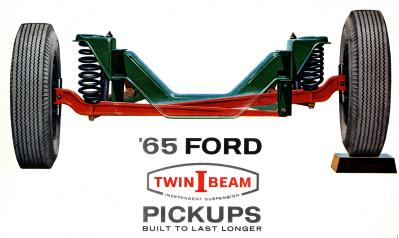
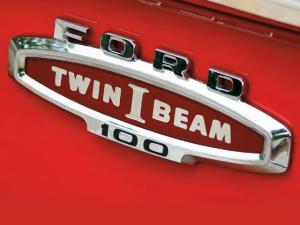
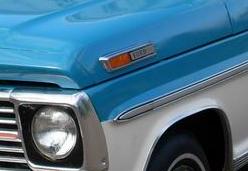
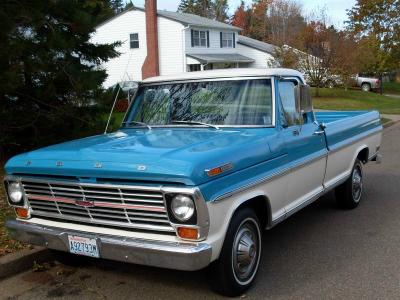
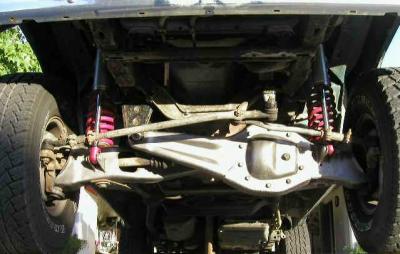
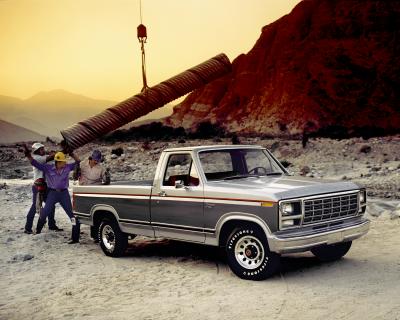
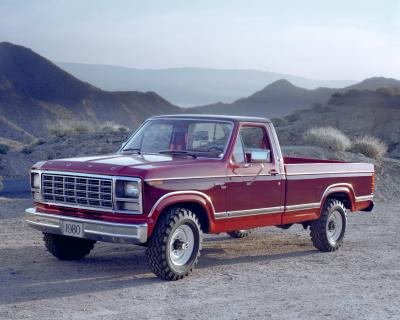
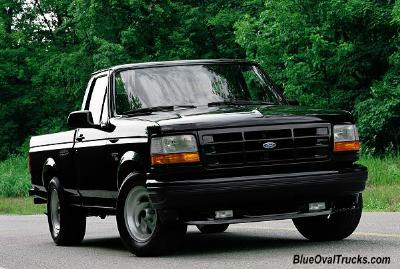


![Dracula: Complete Legacy Collection [Blu-ray]](https://m.media-amazon.com/images/I/51nHXVetd4L.jpg)





